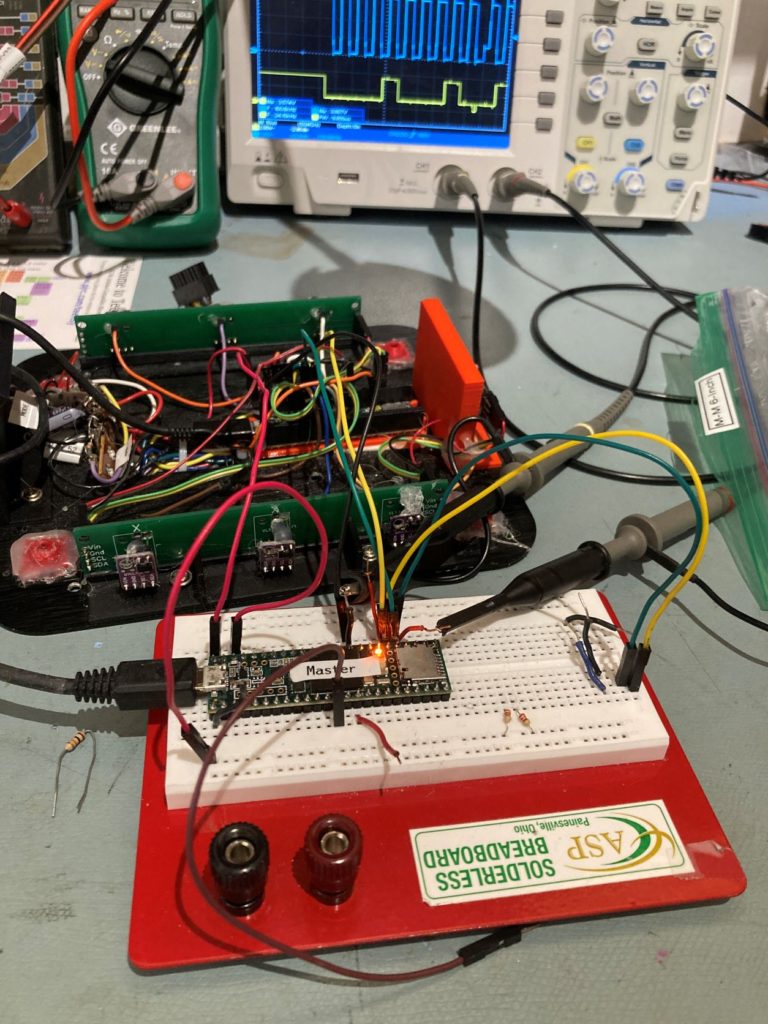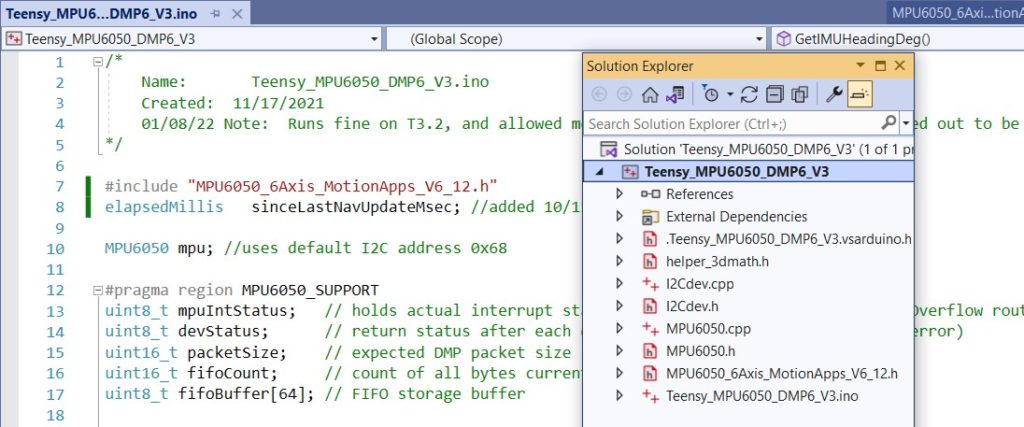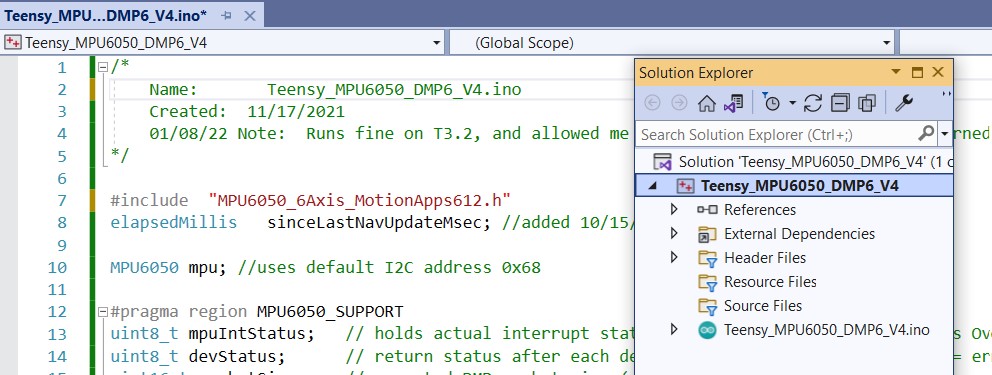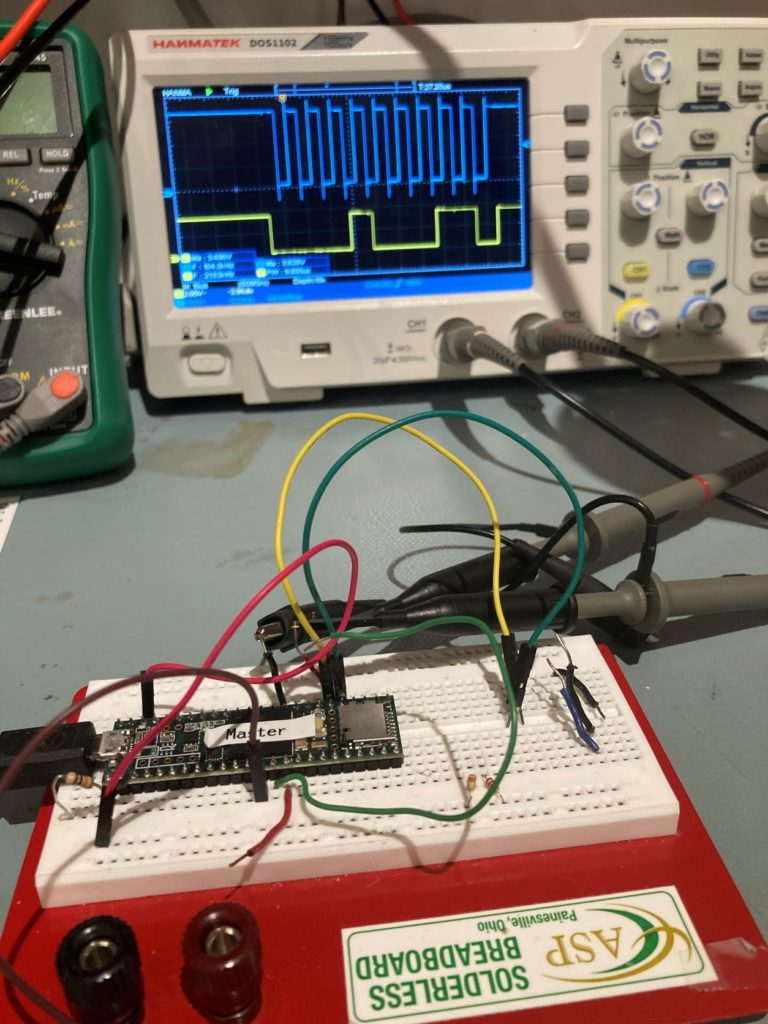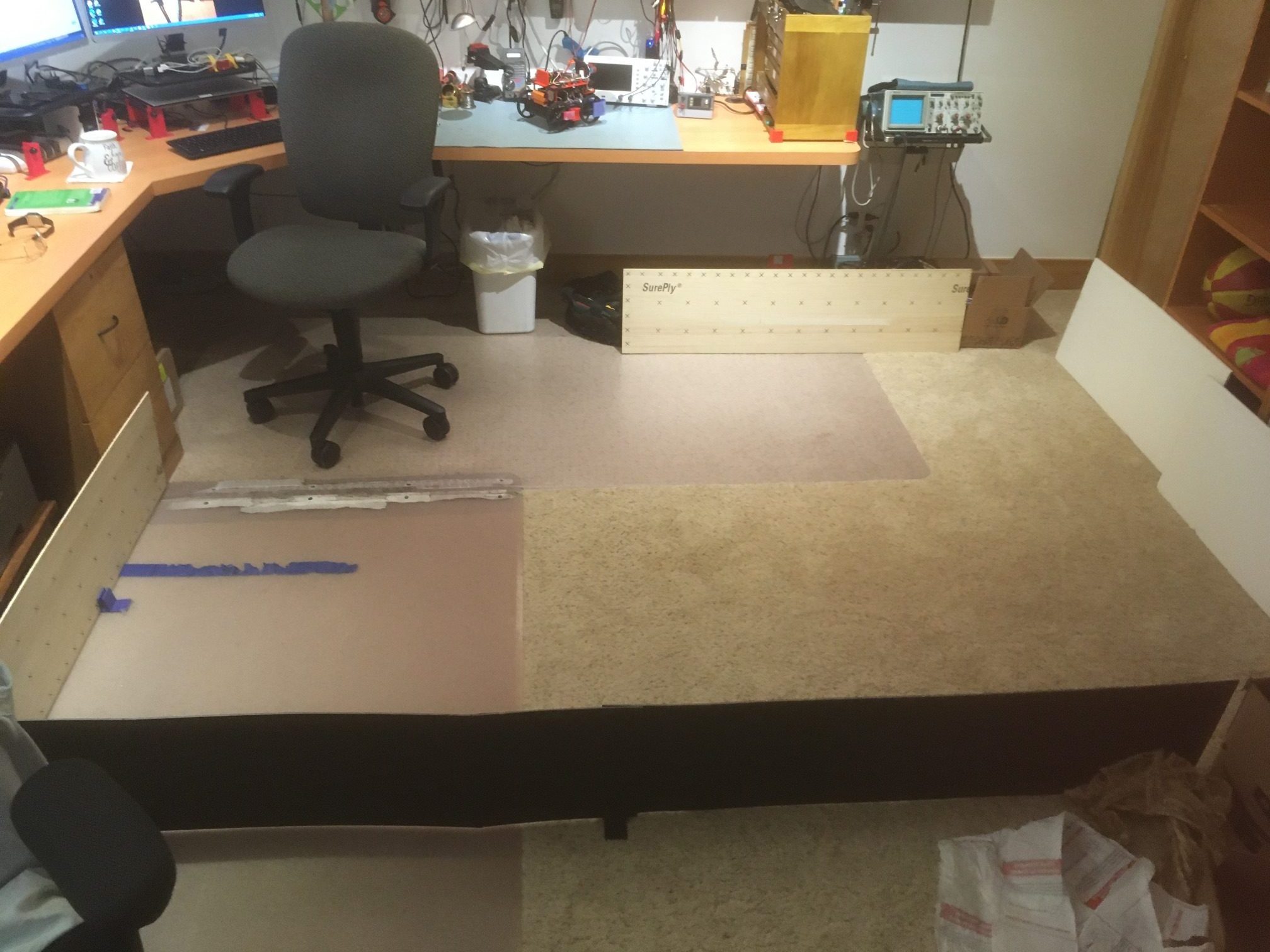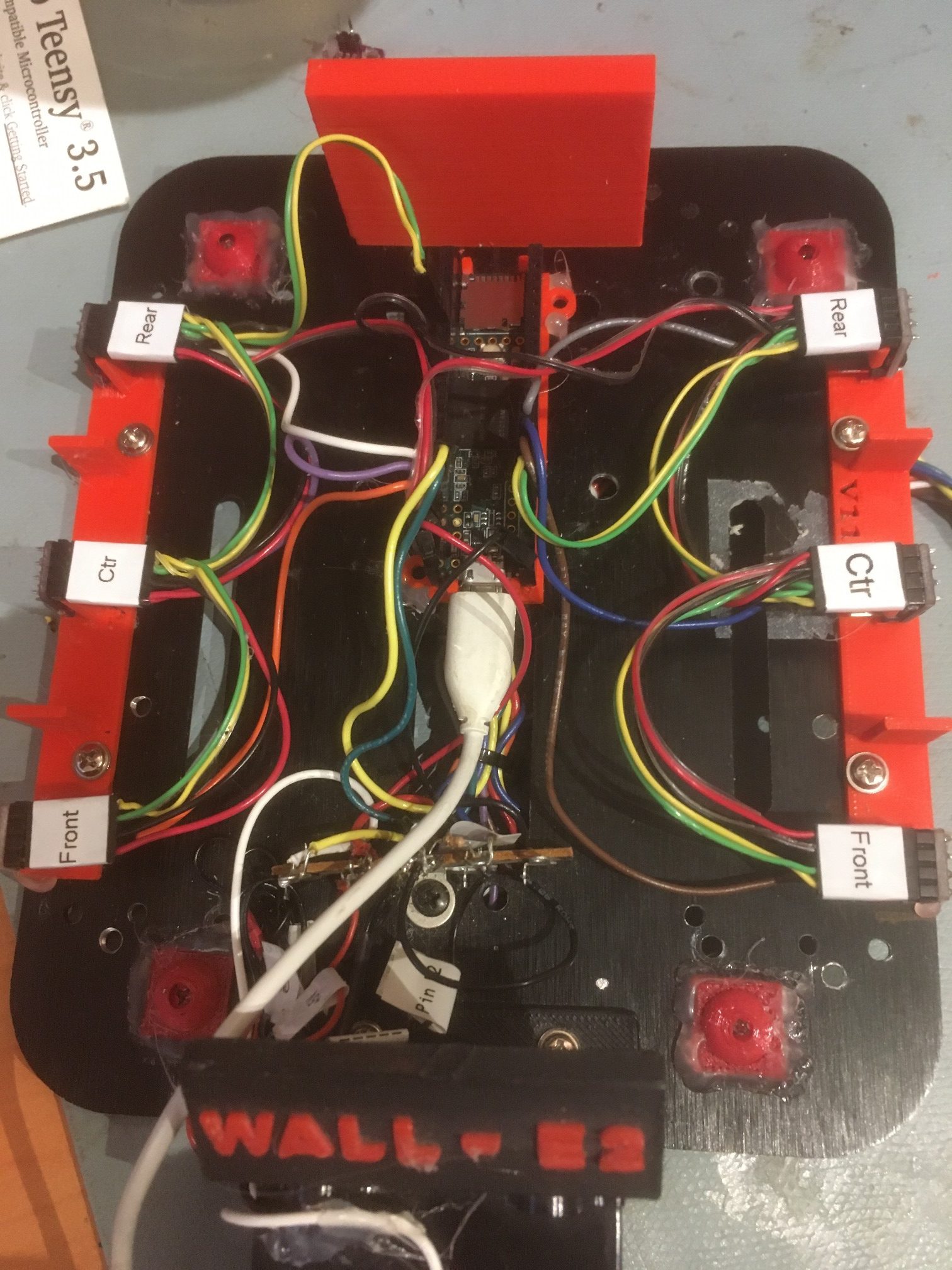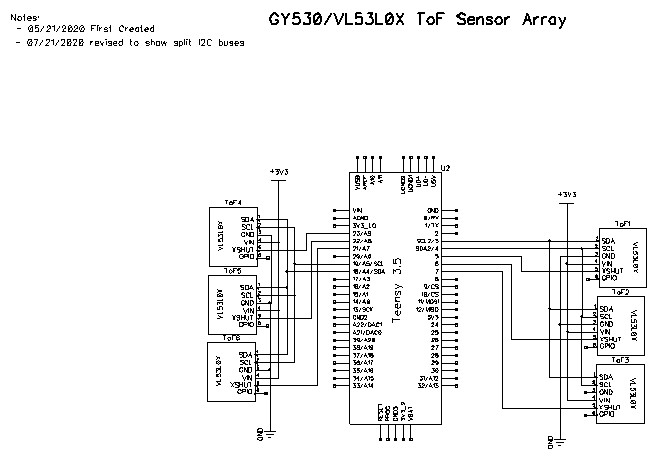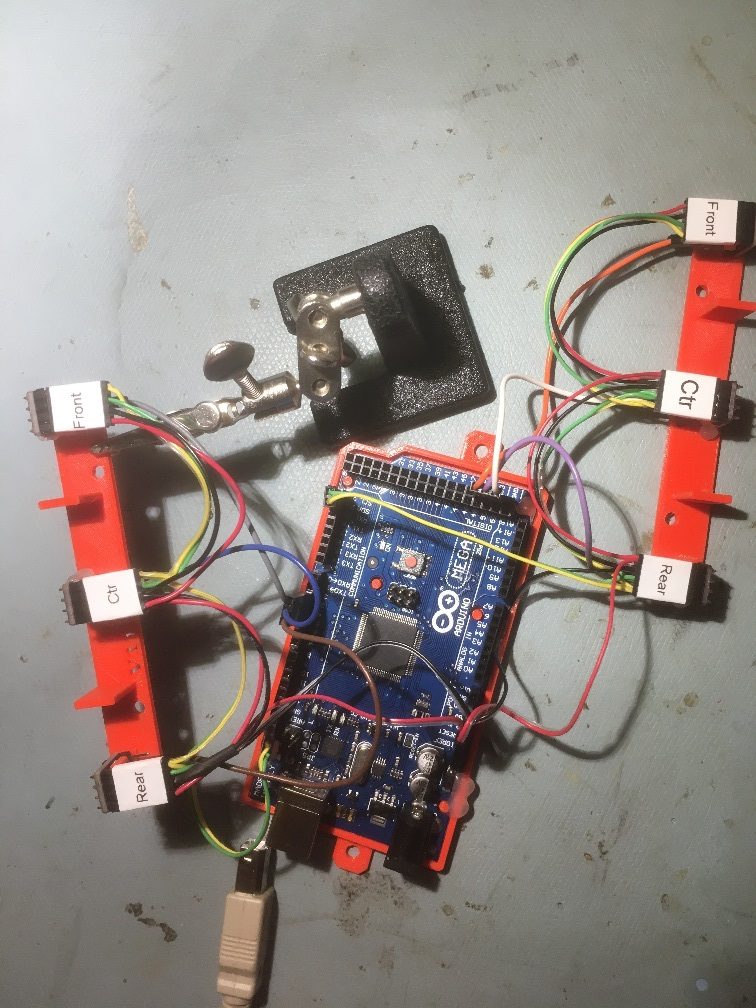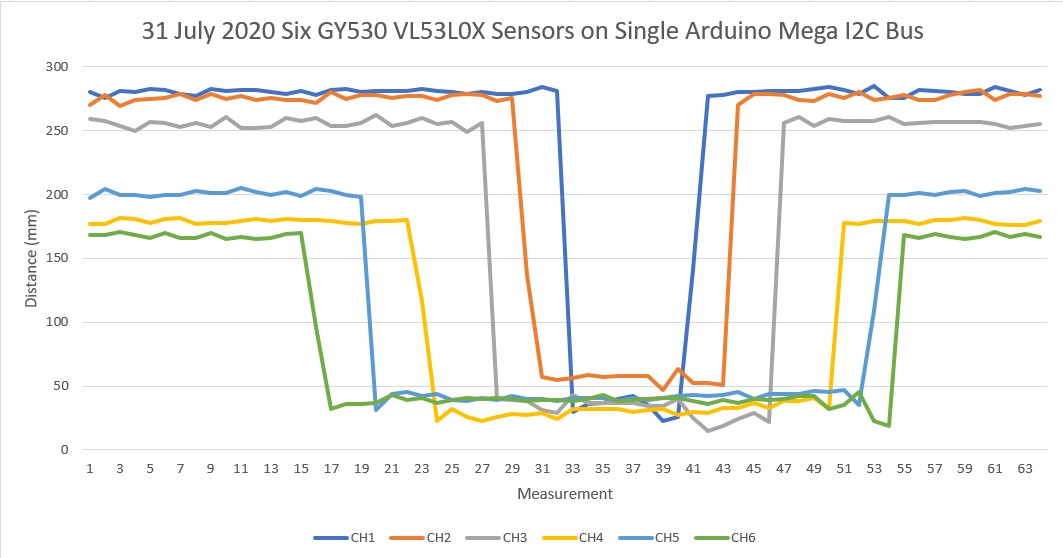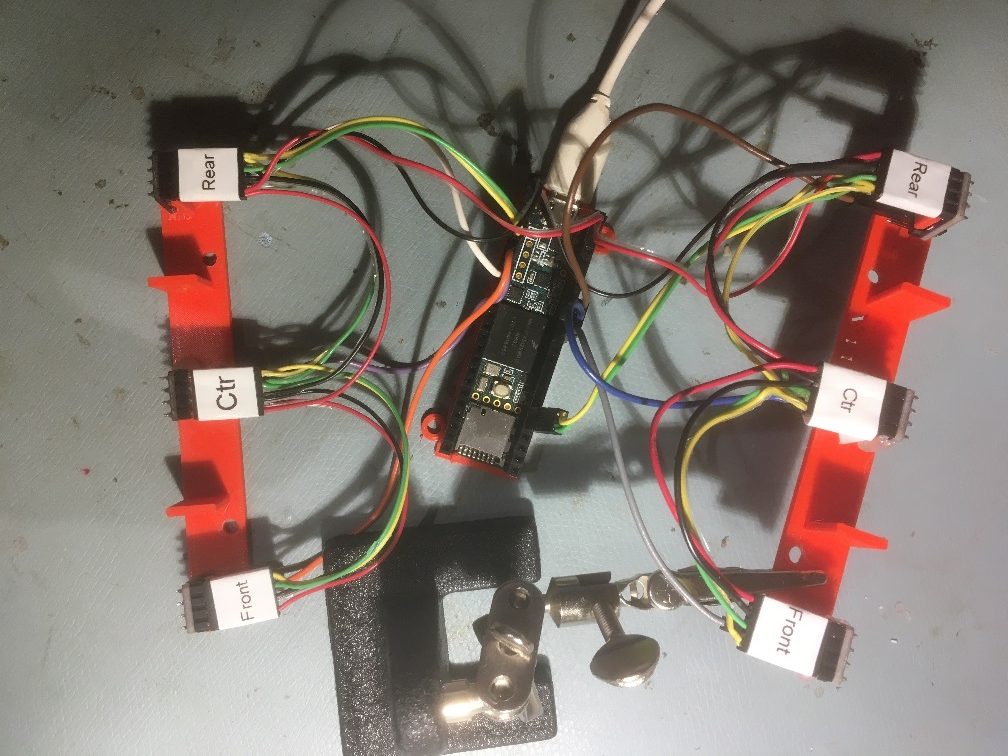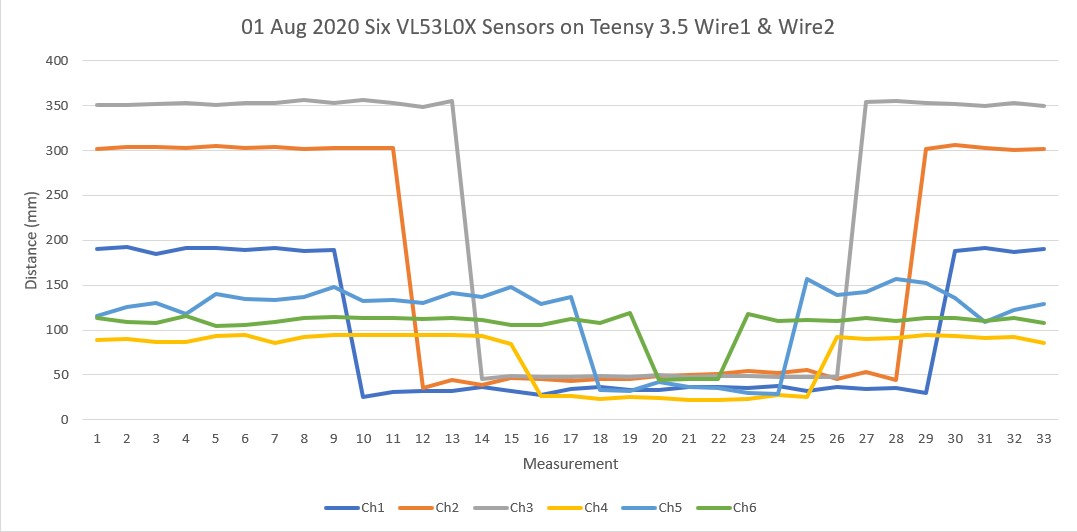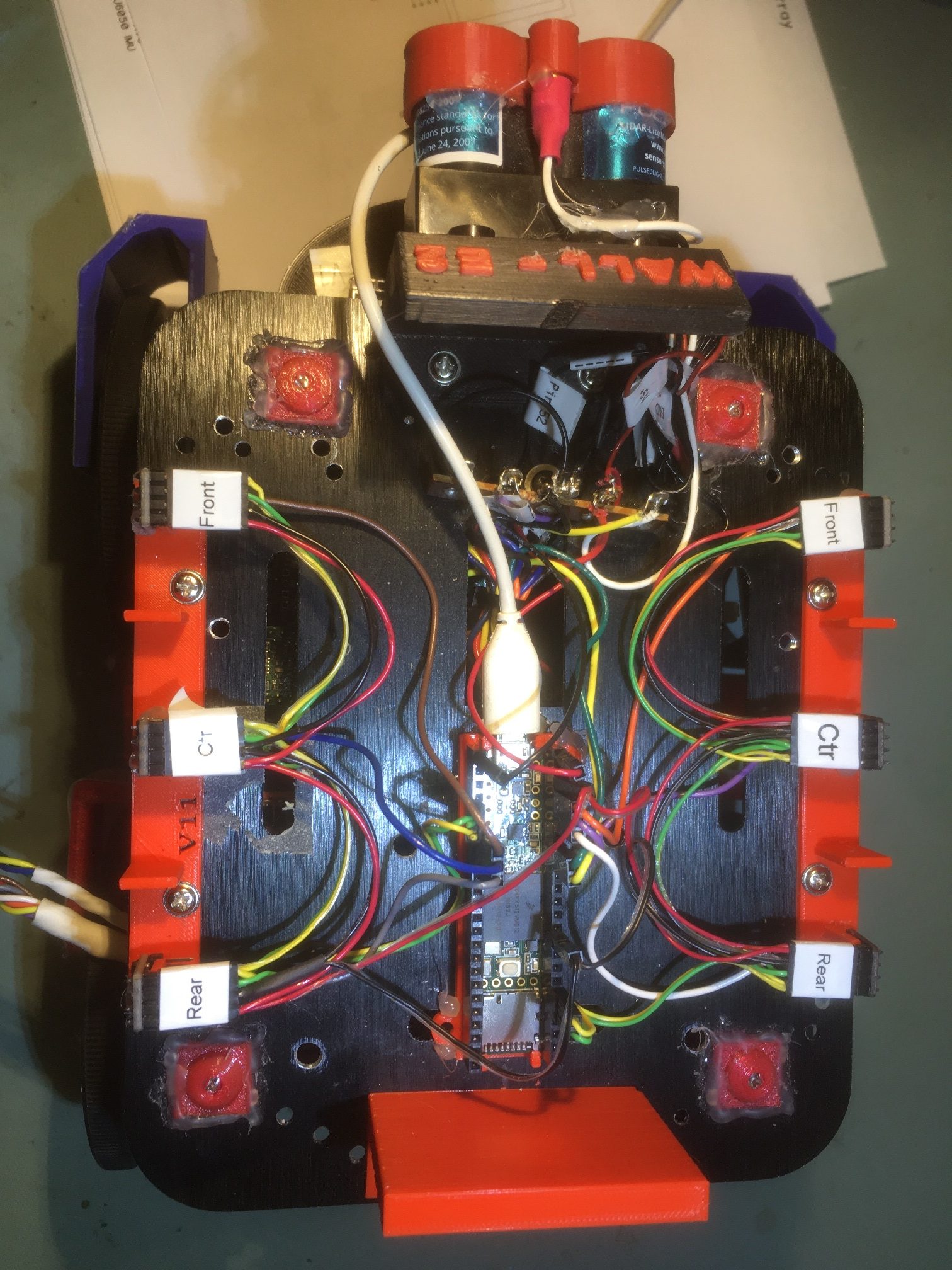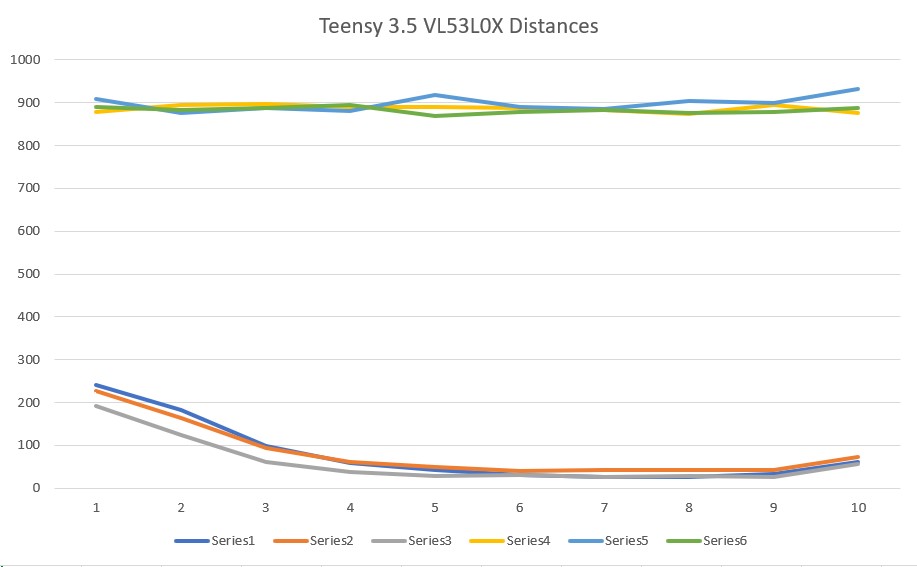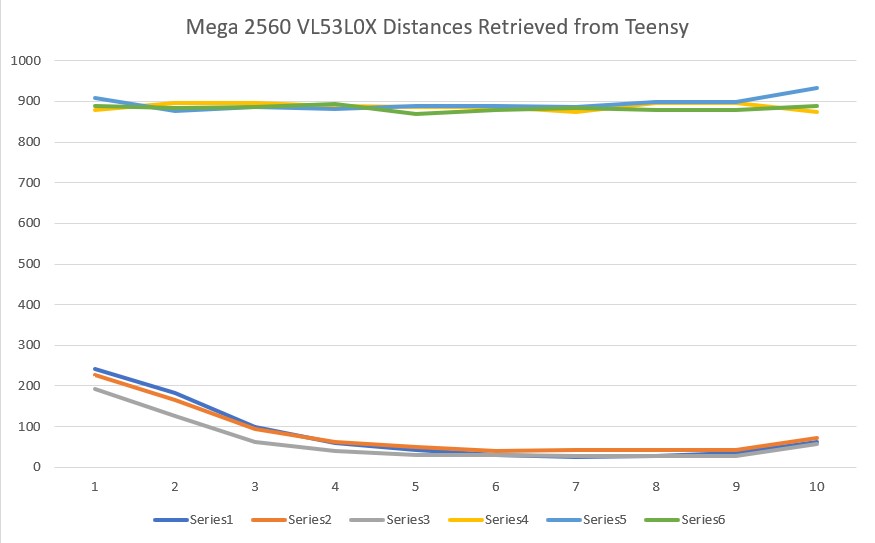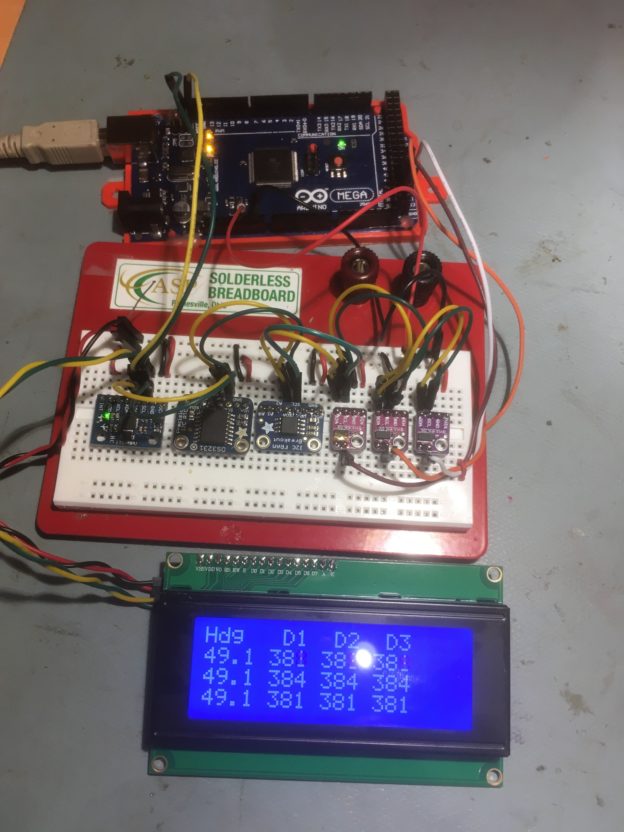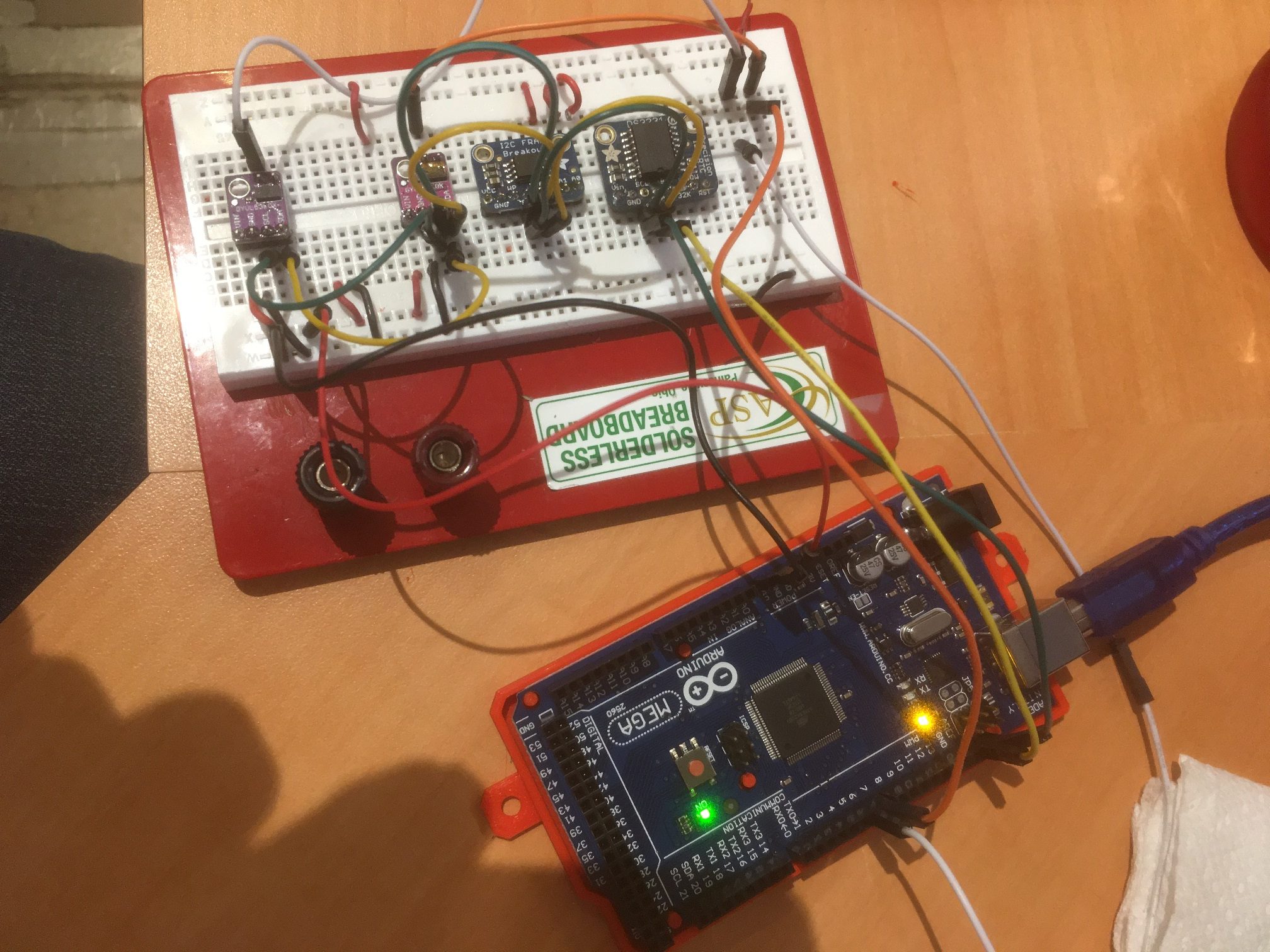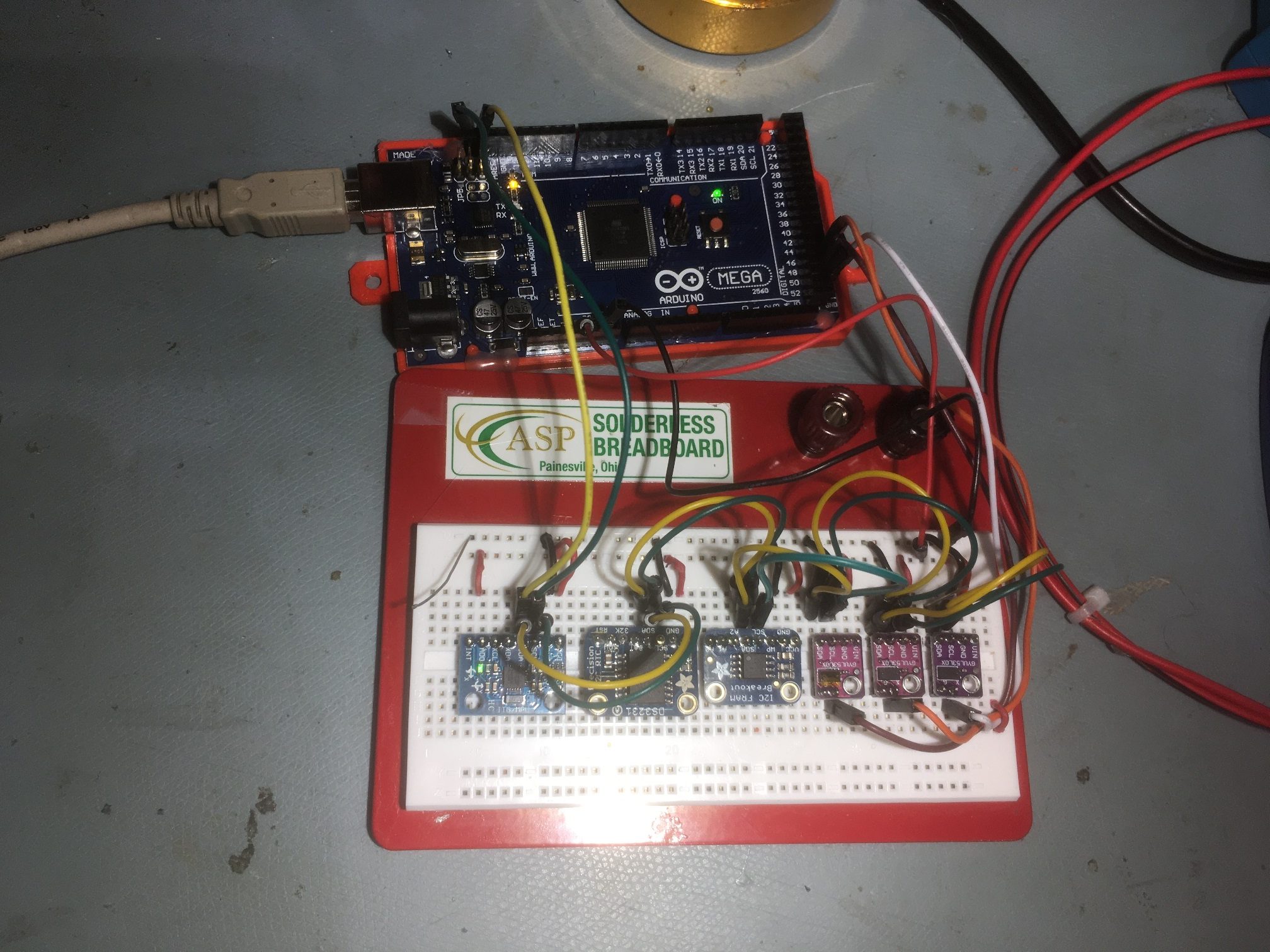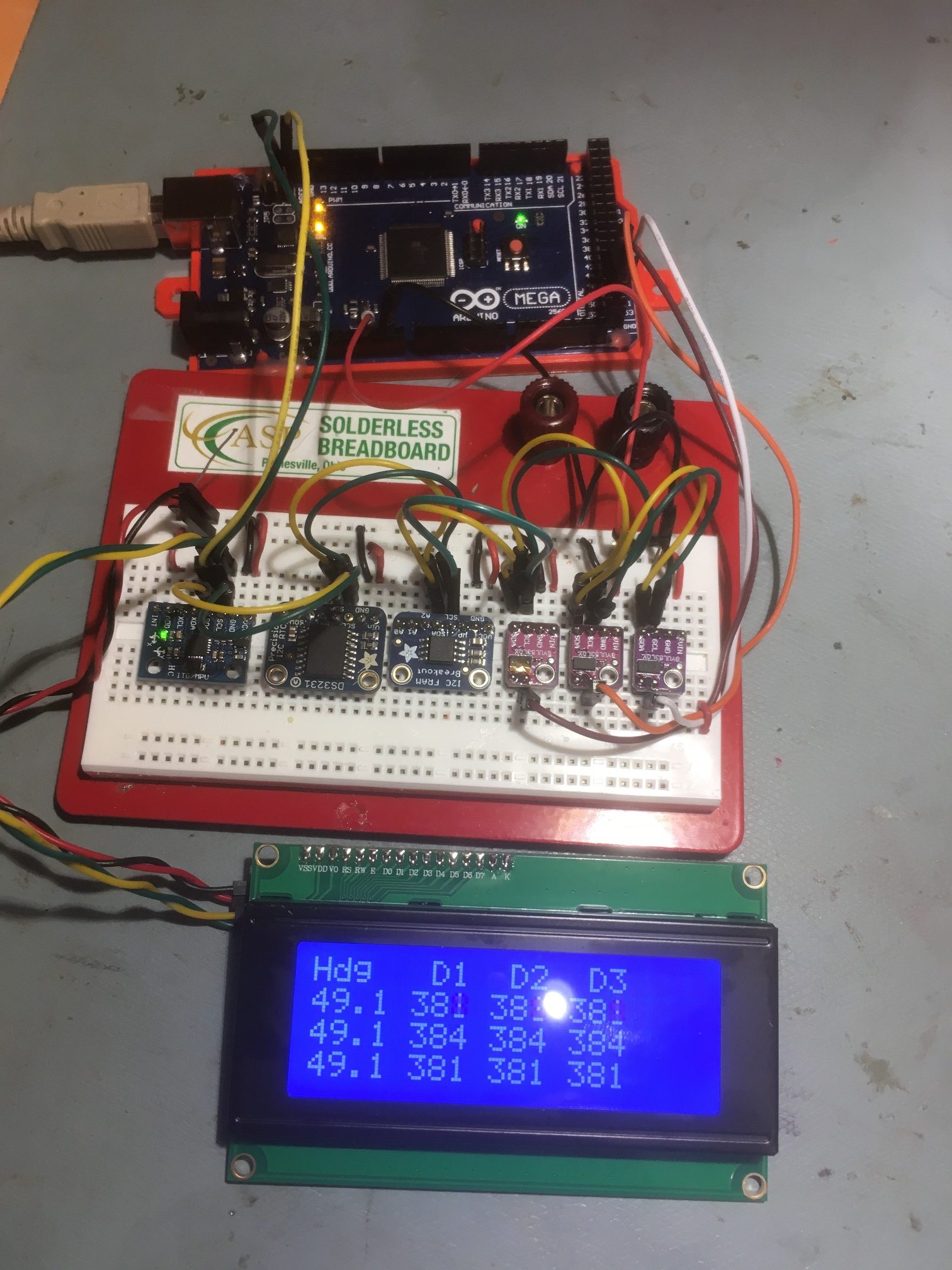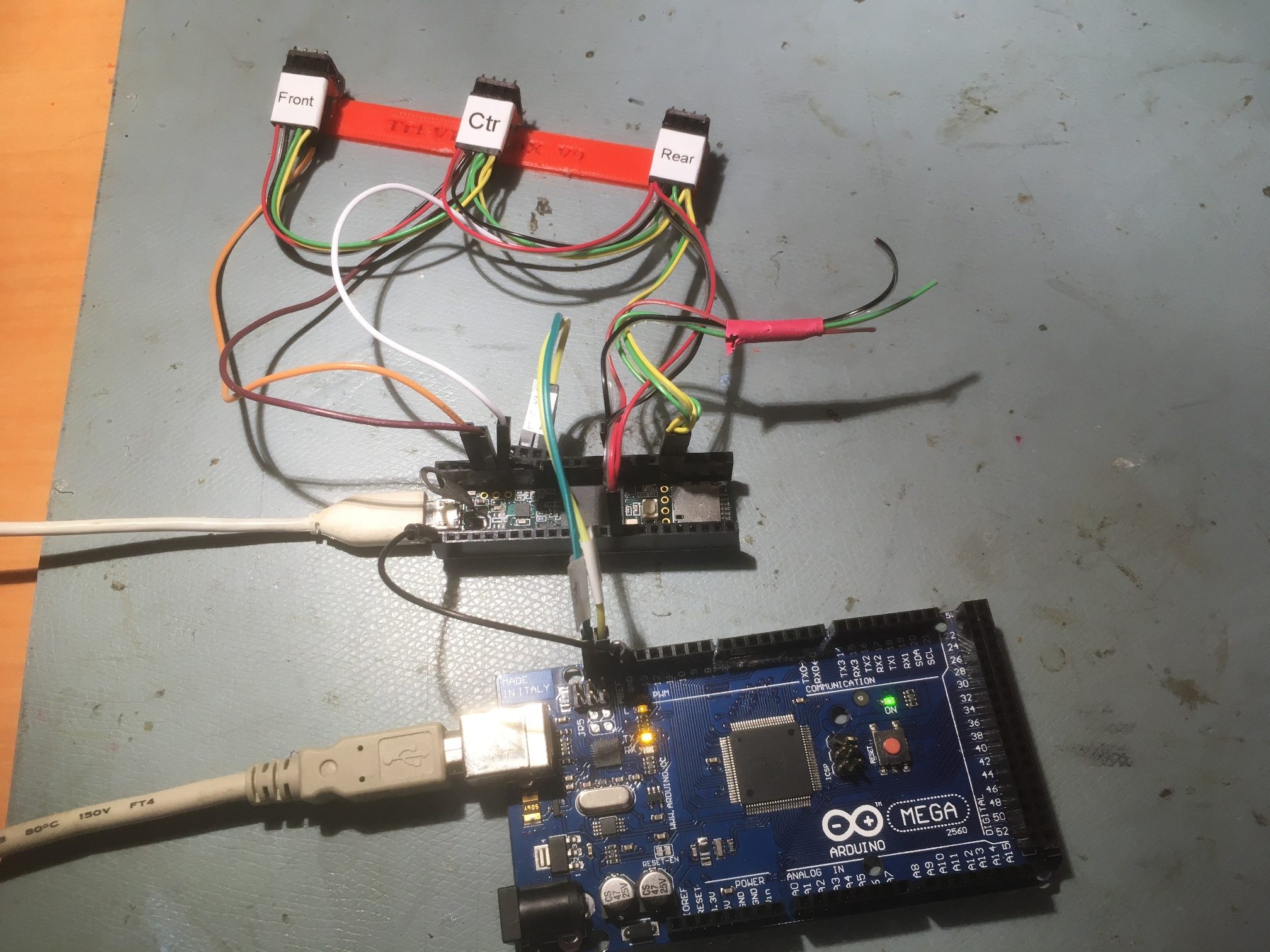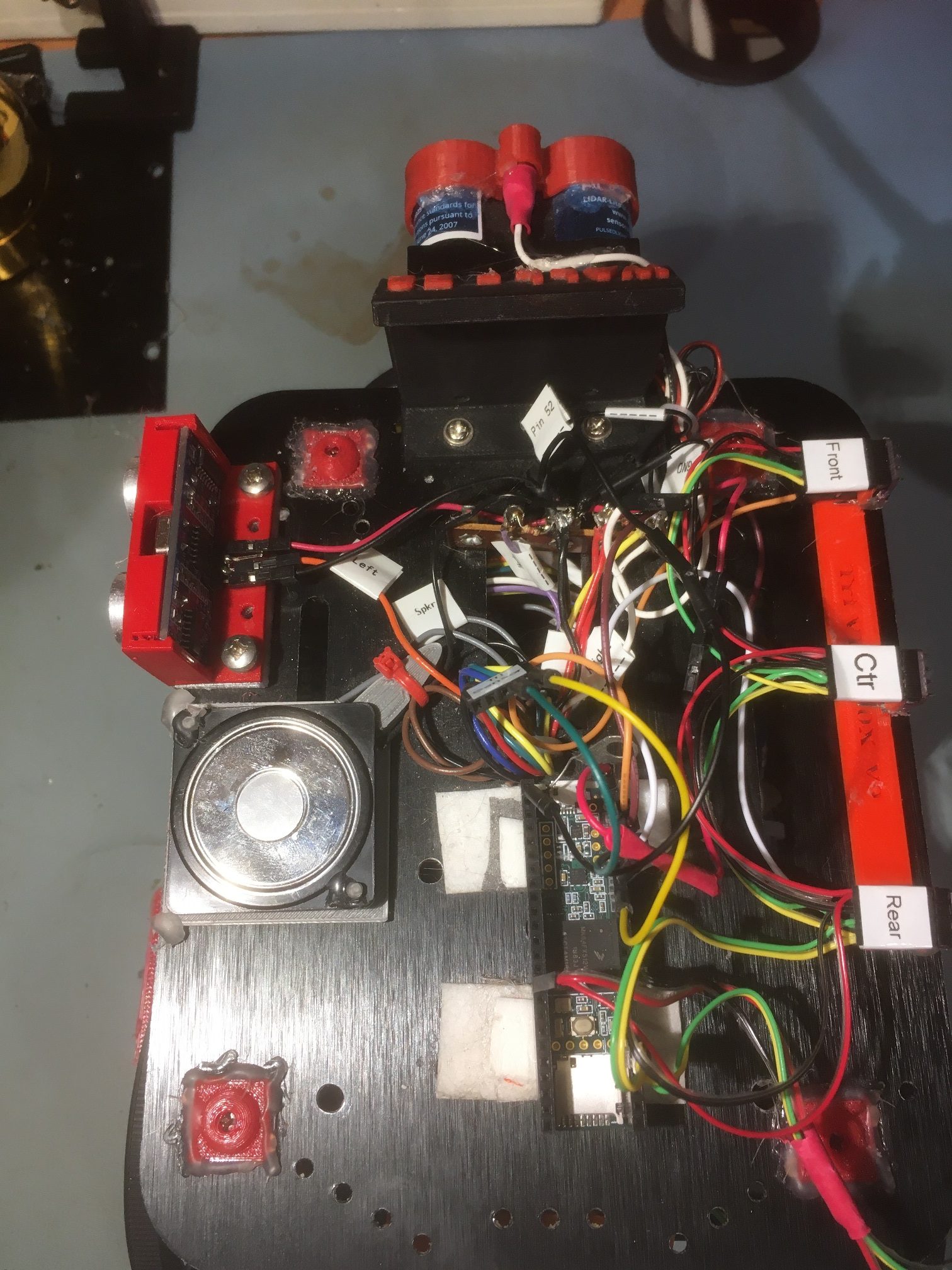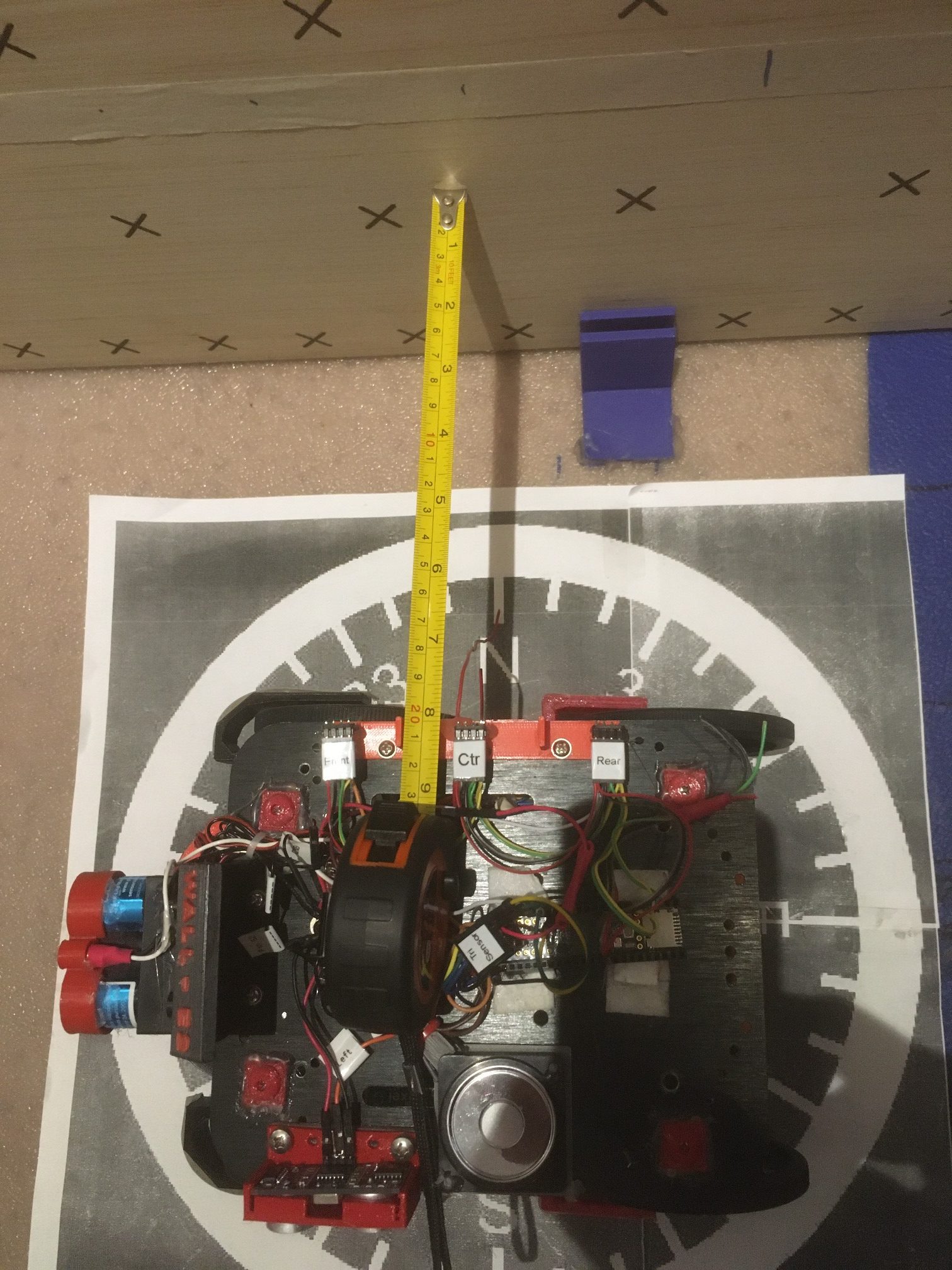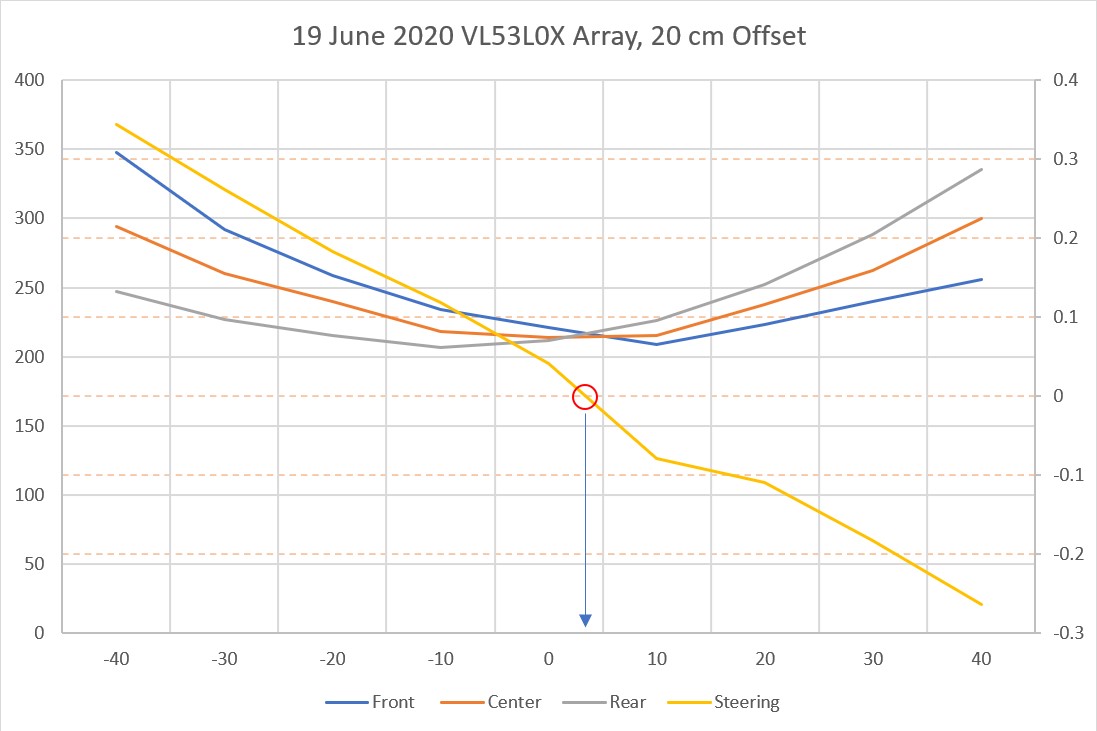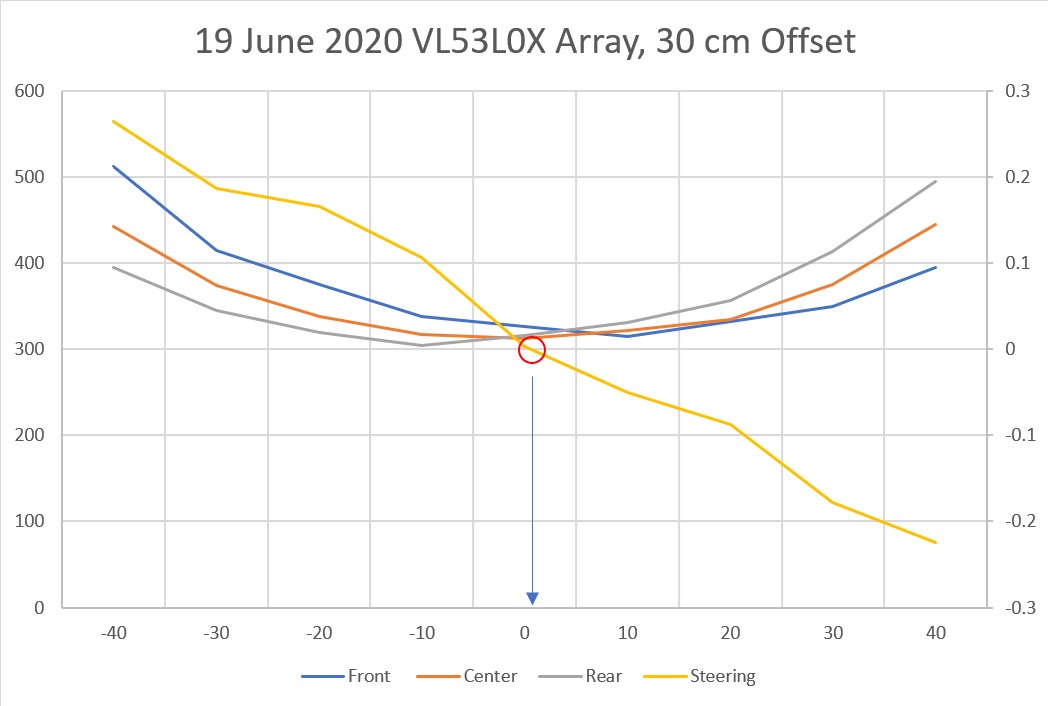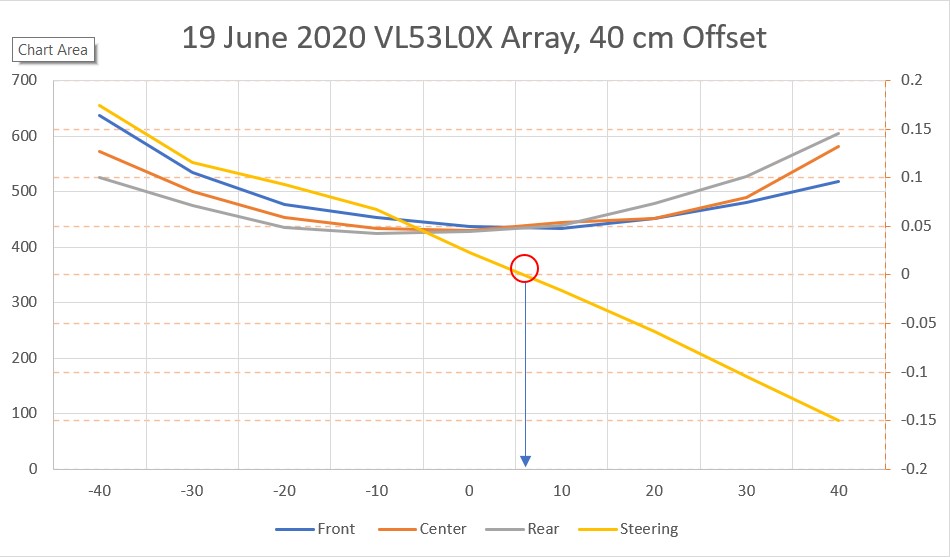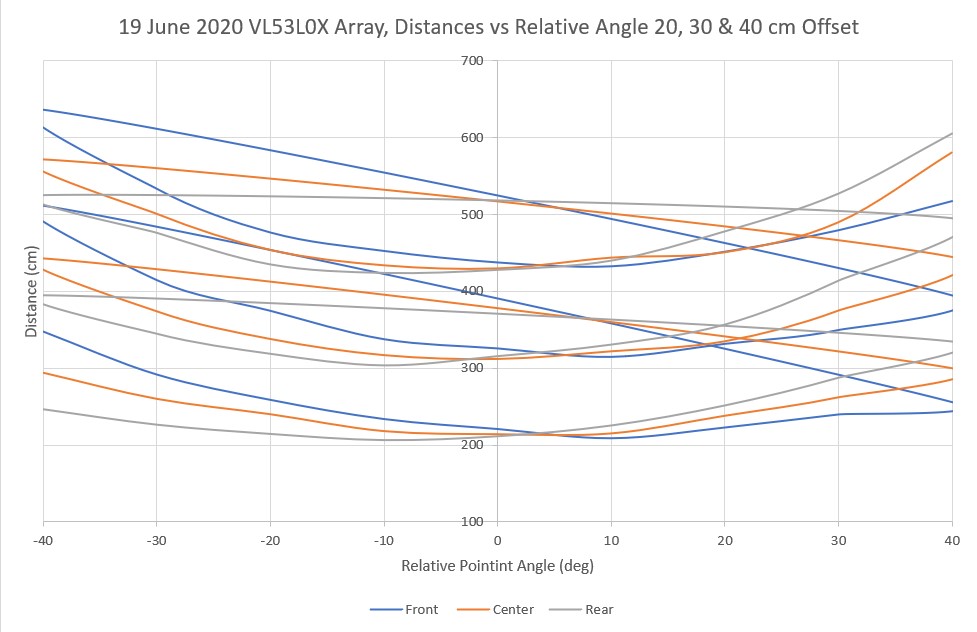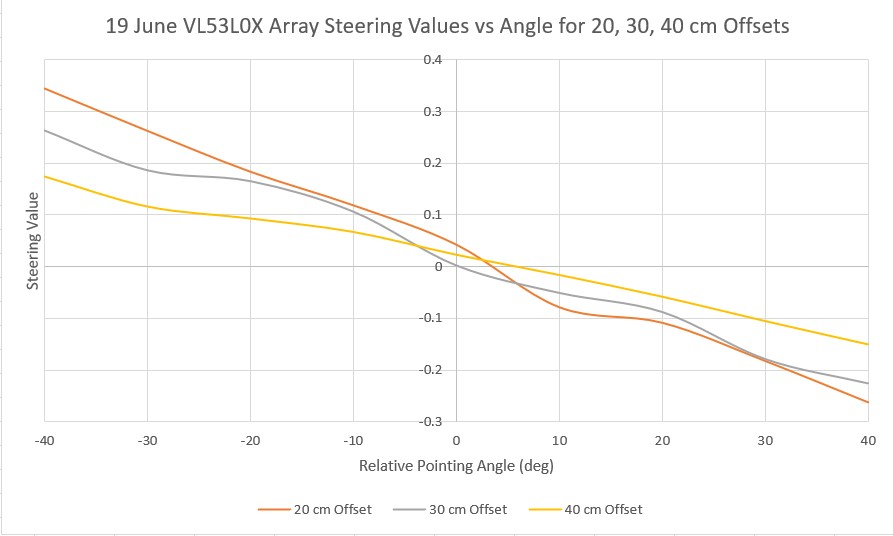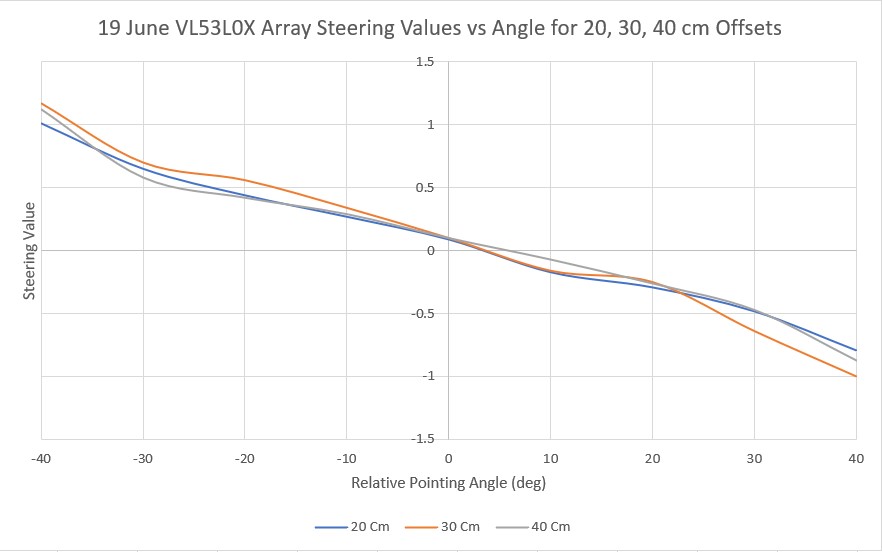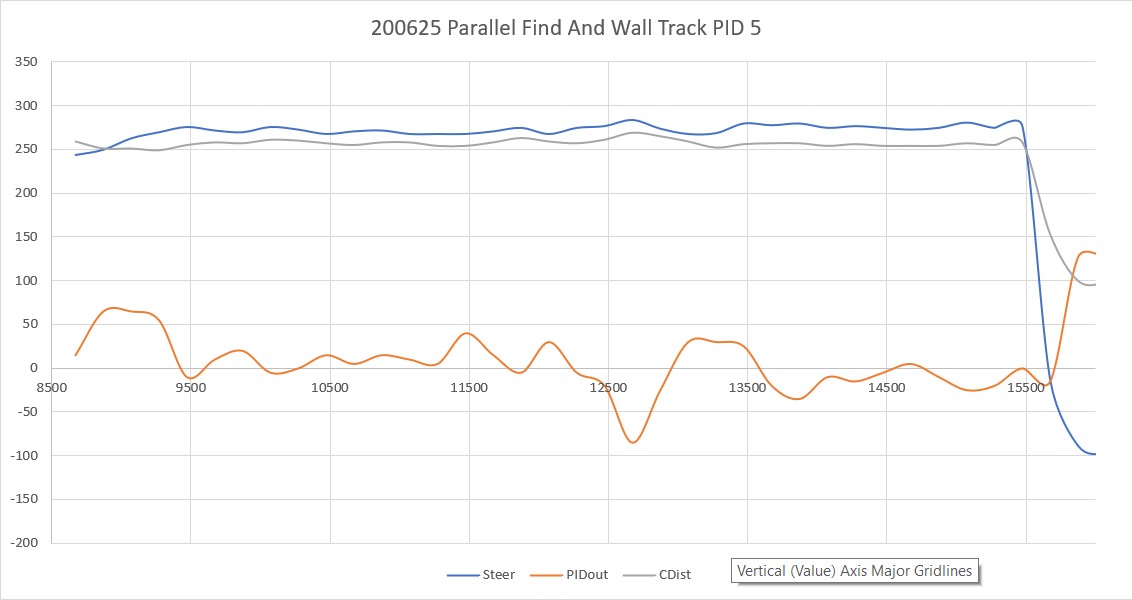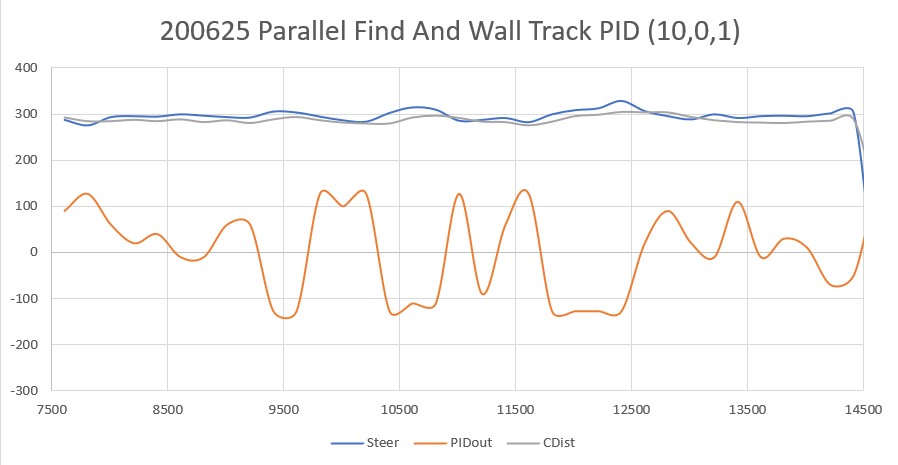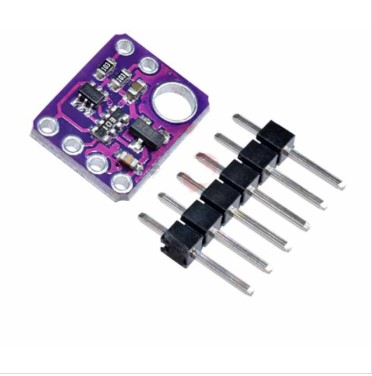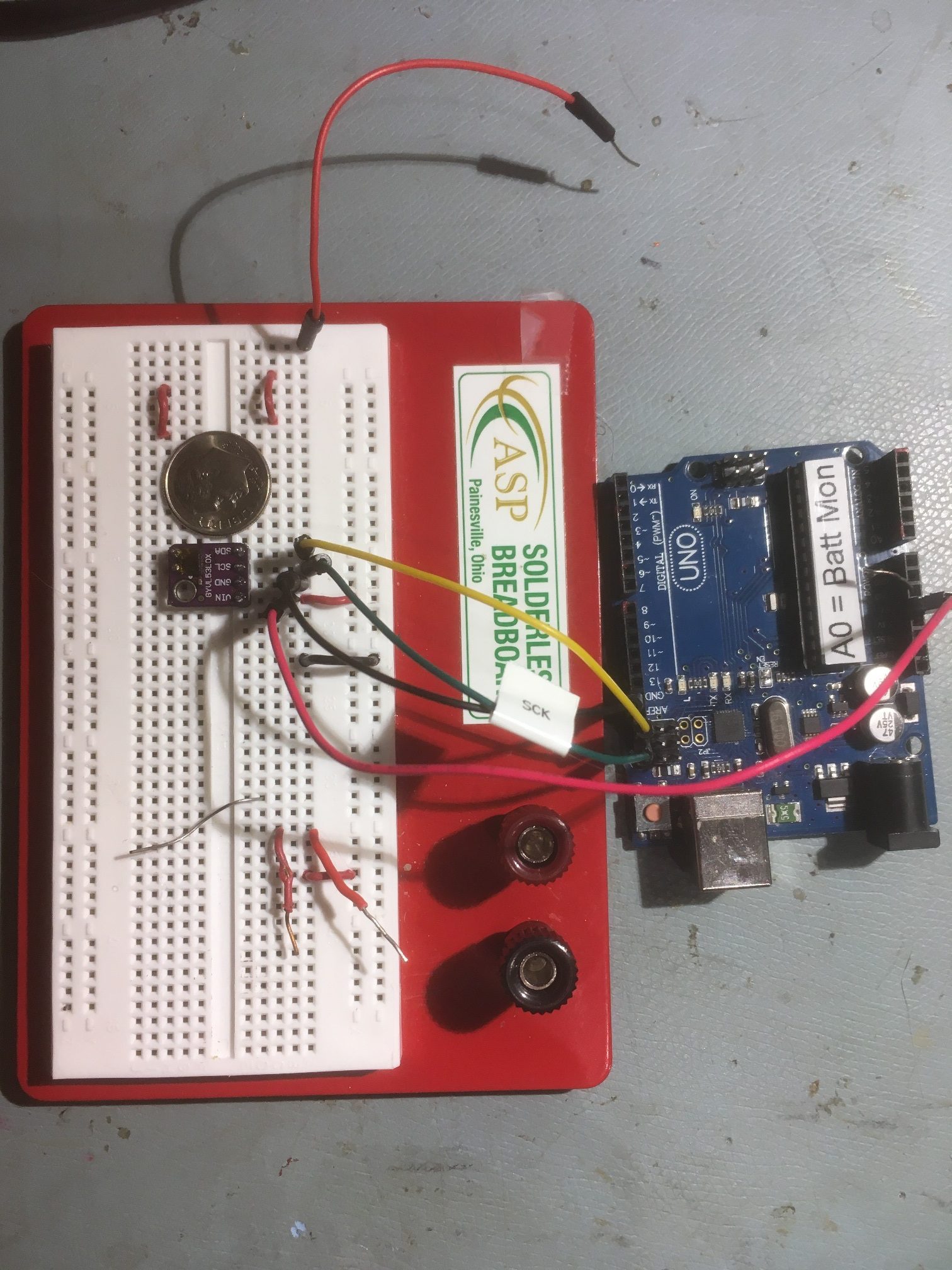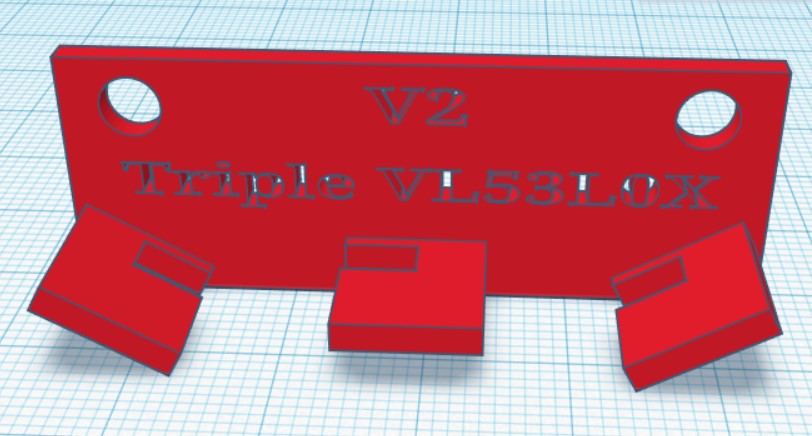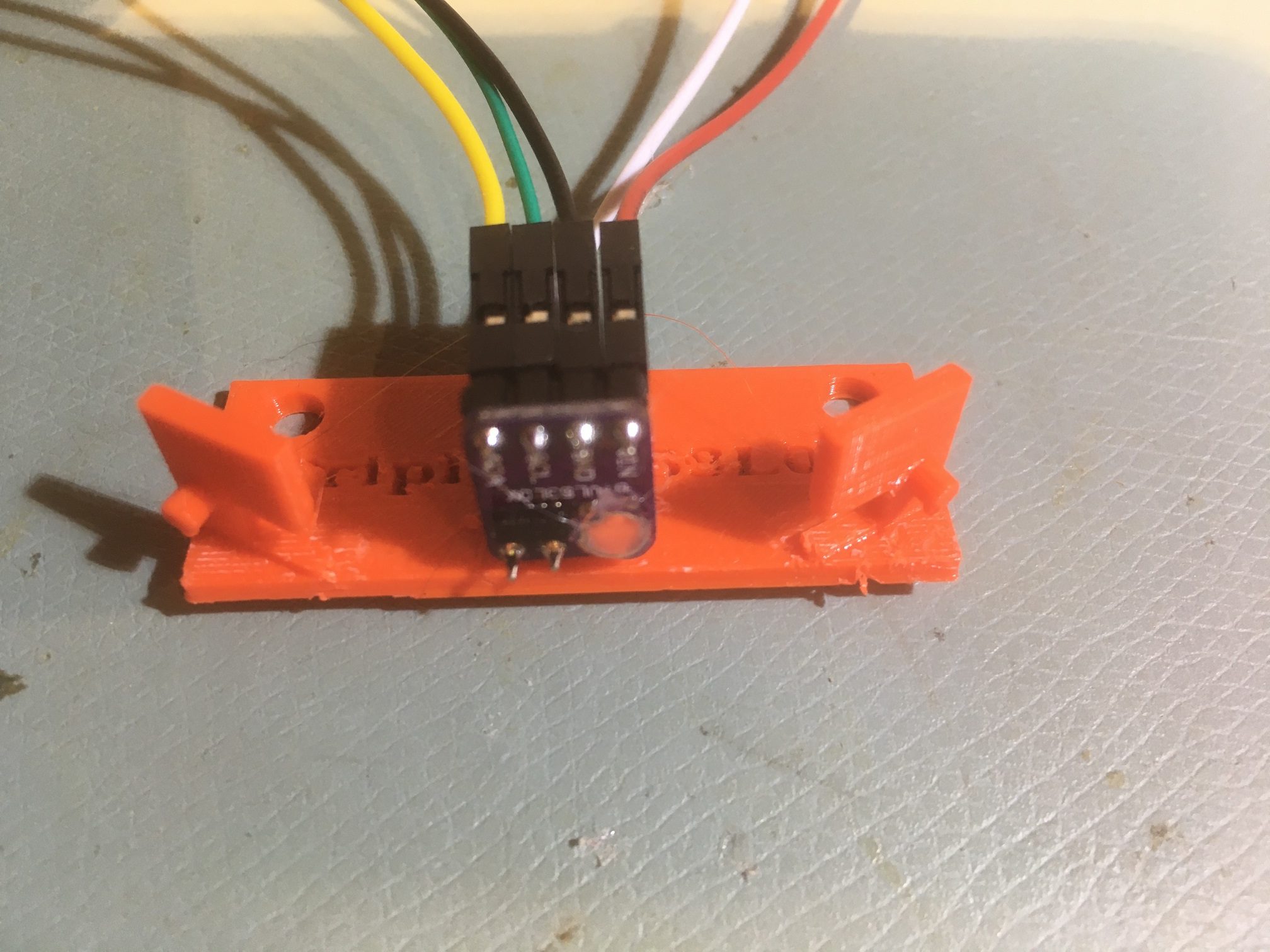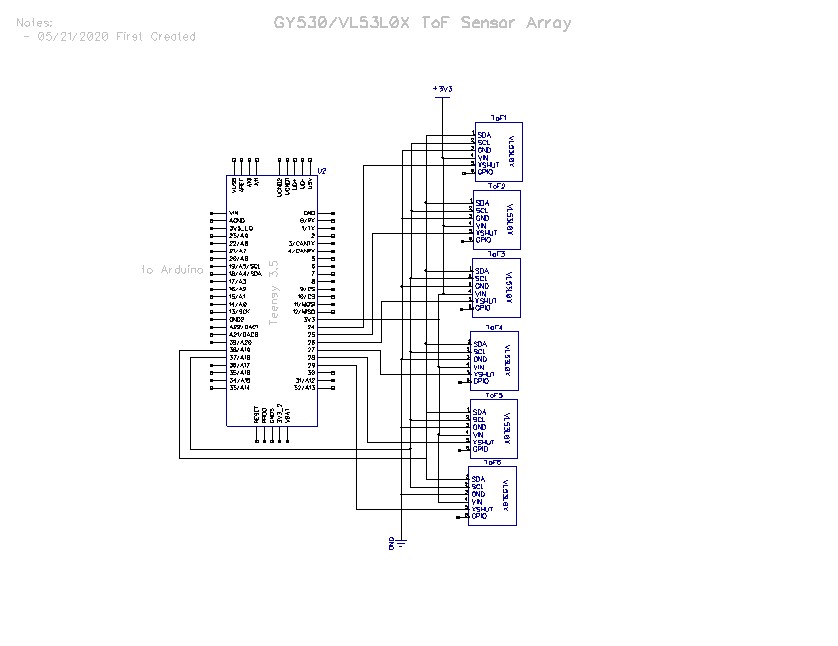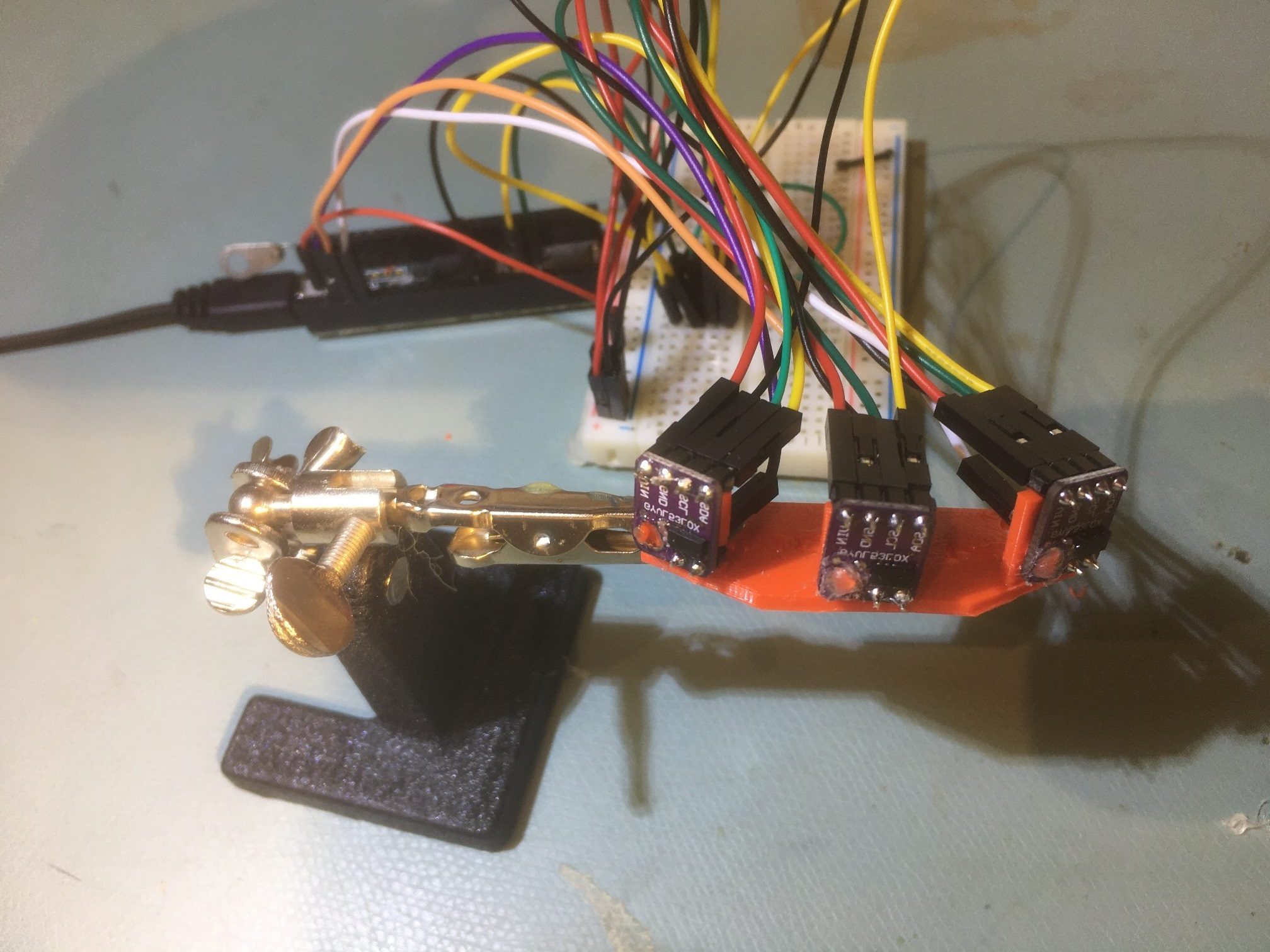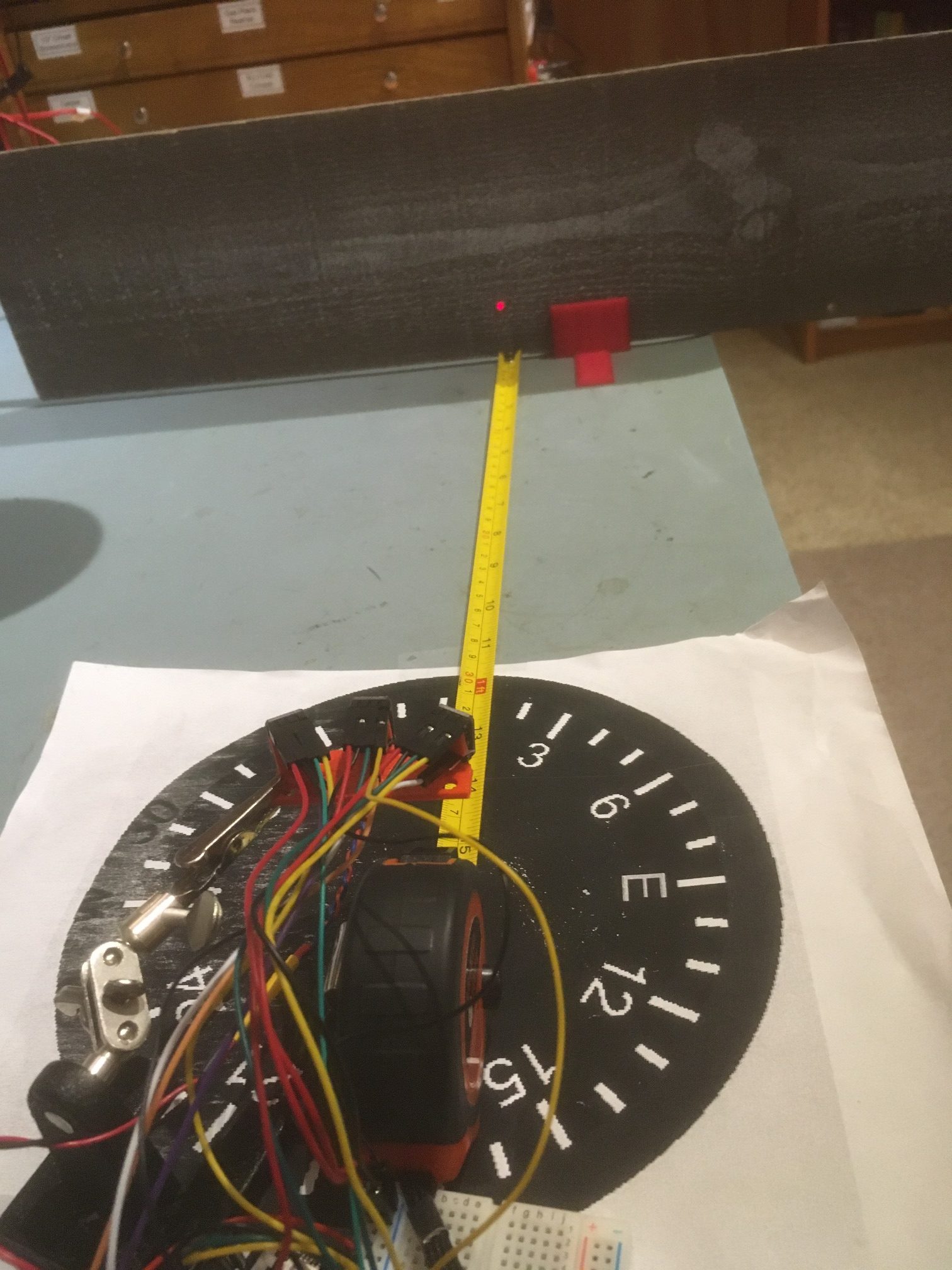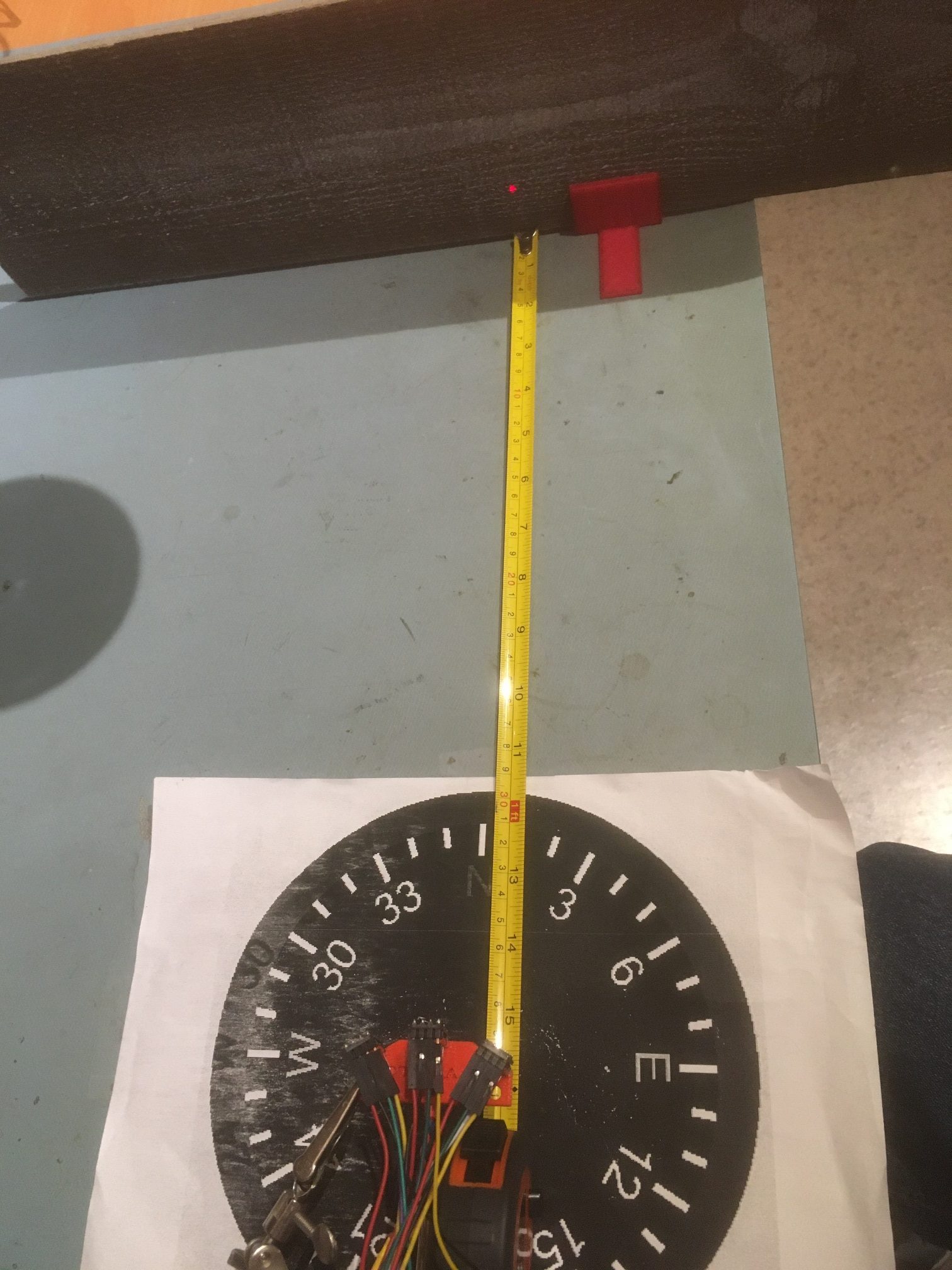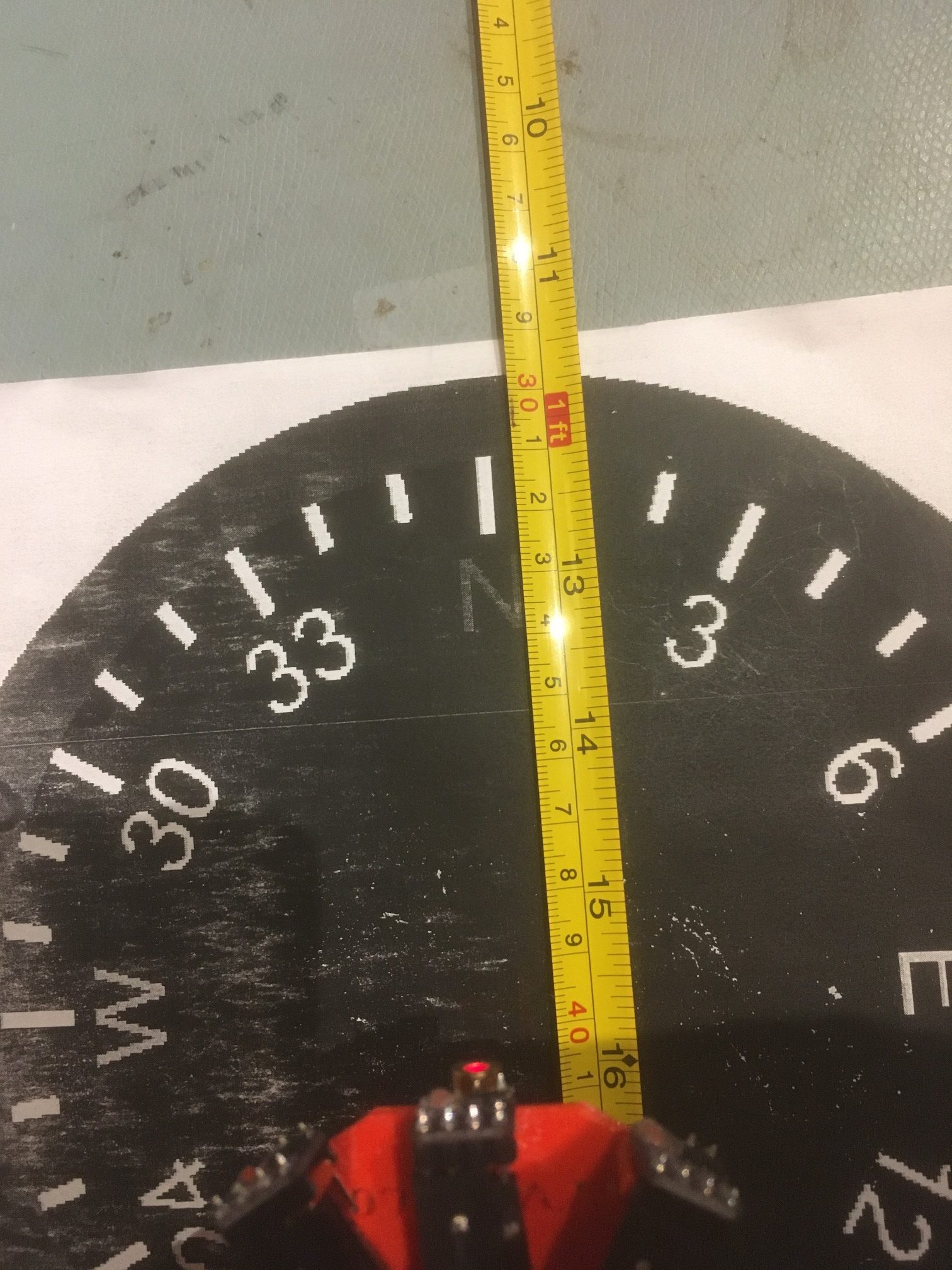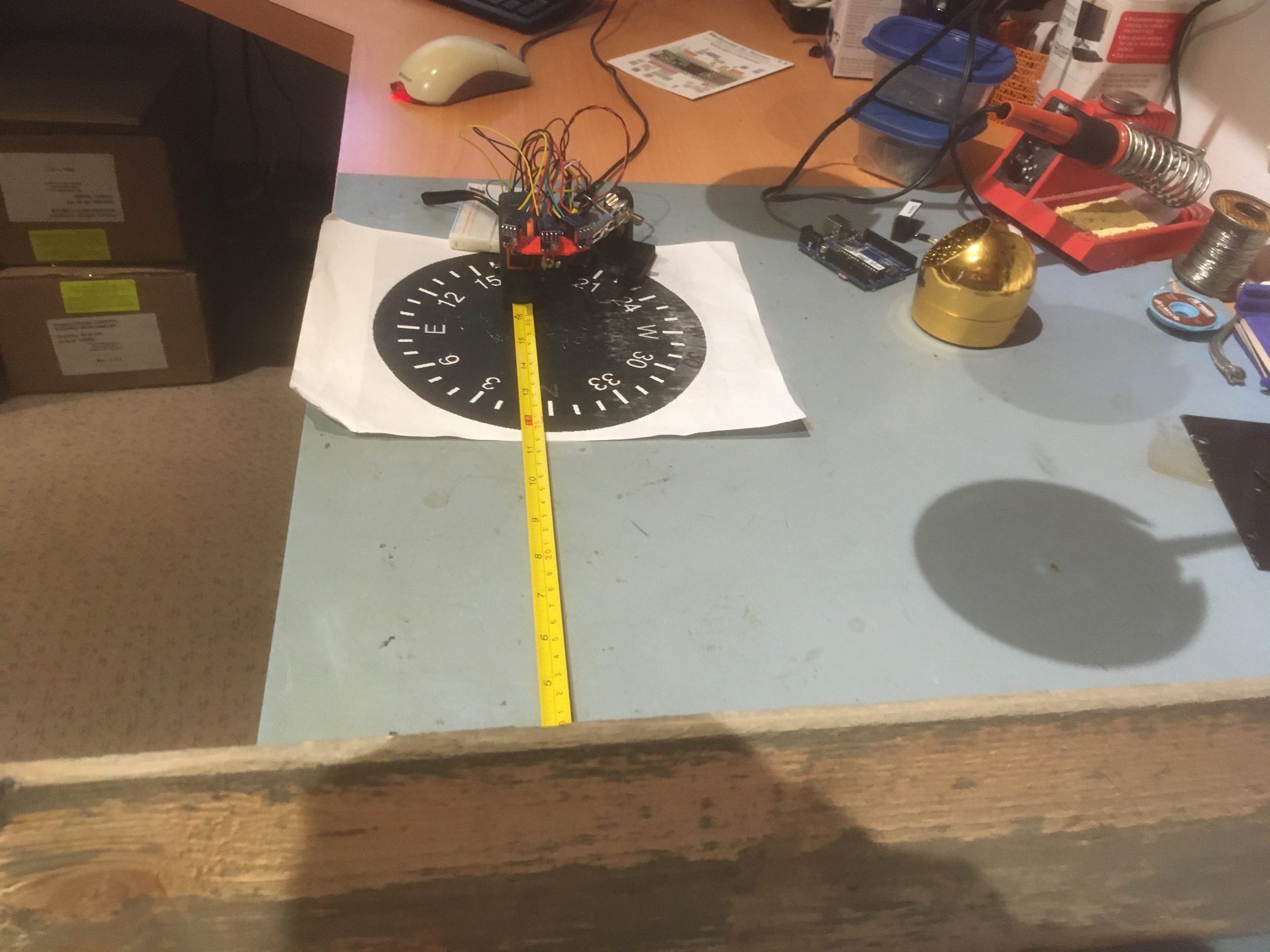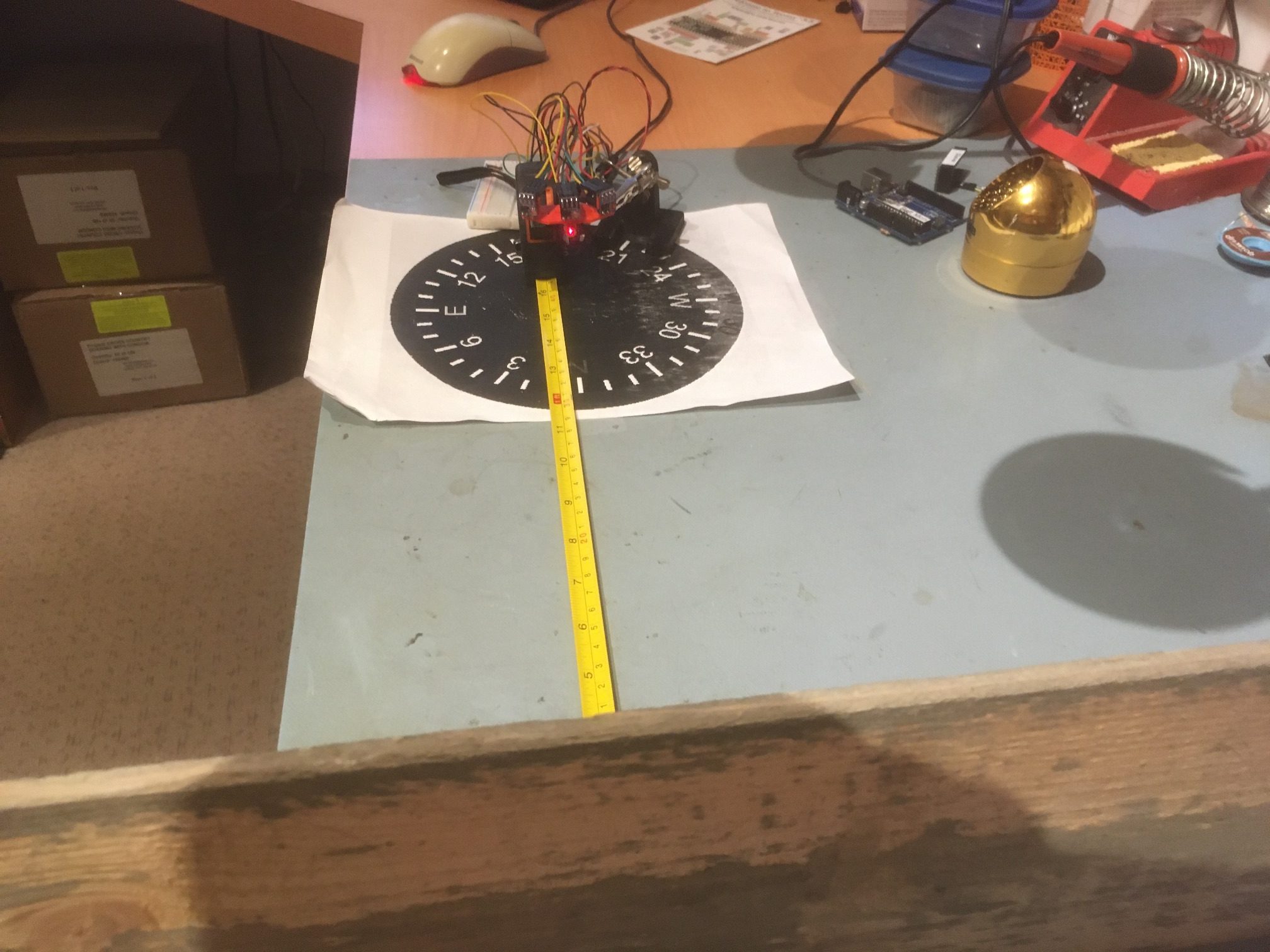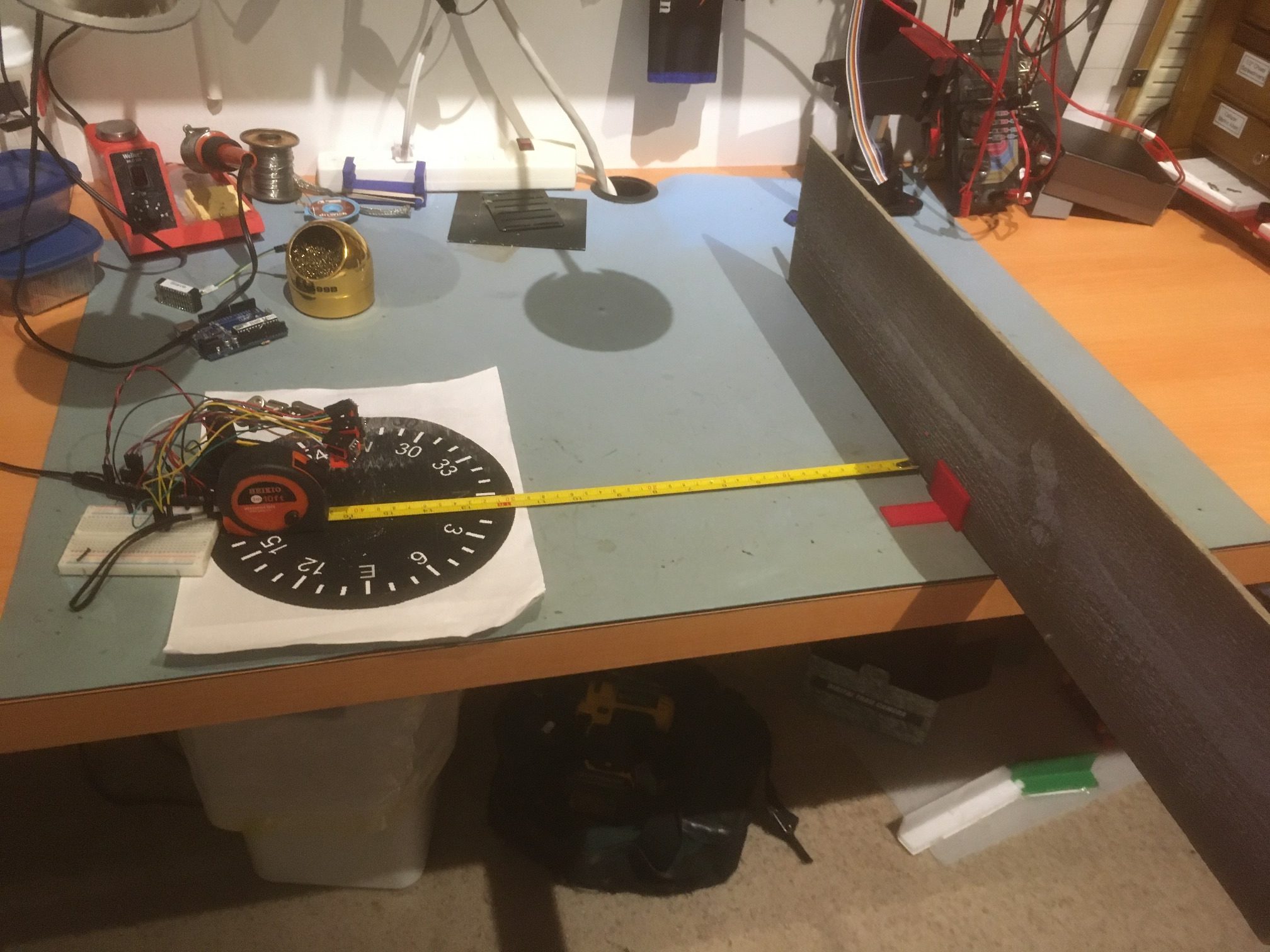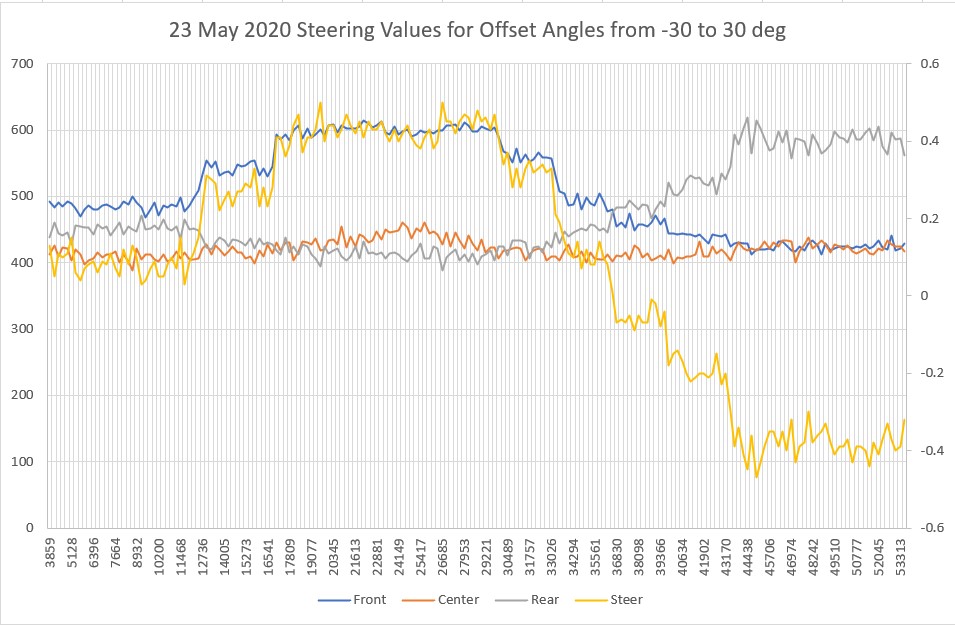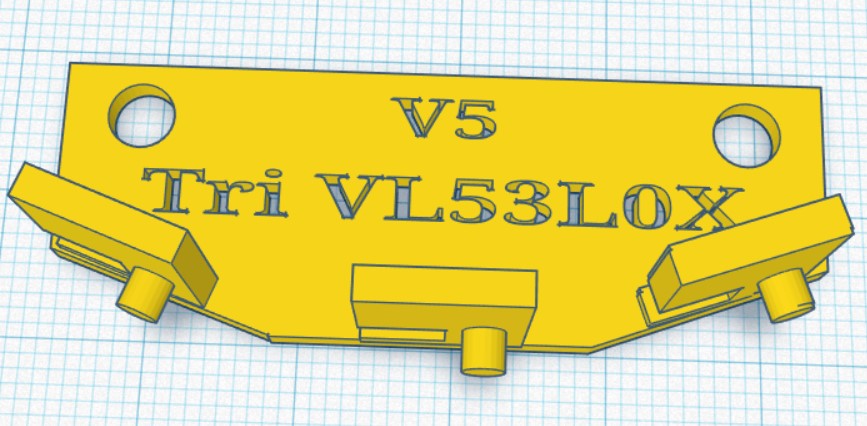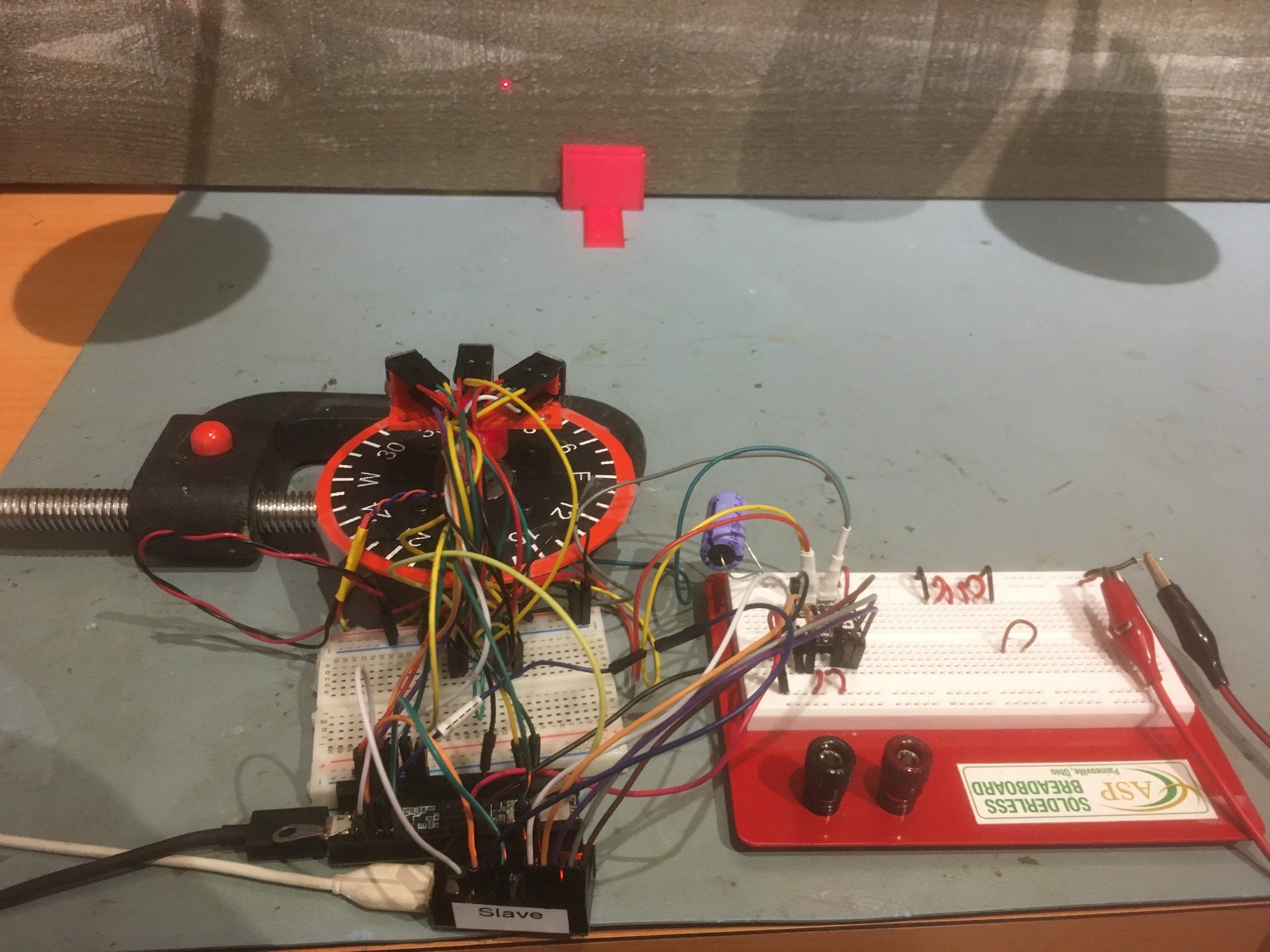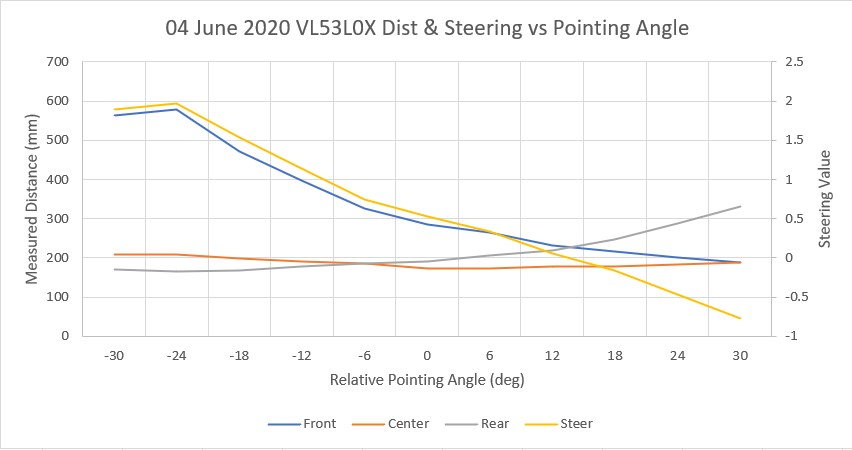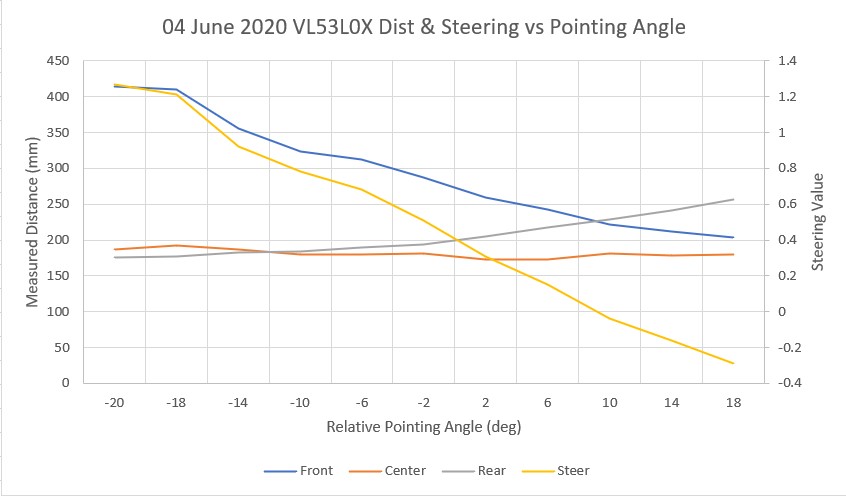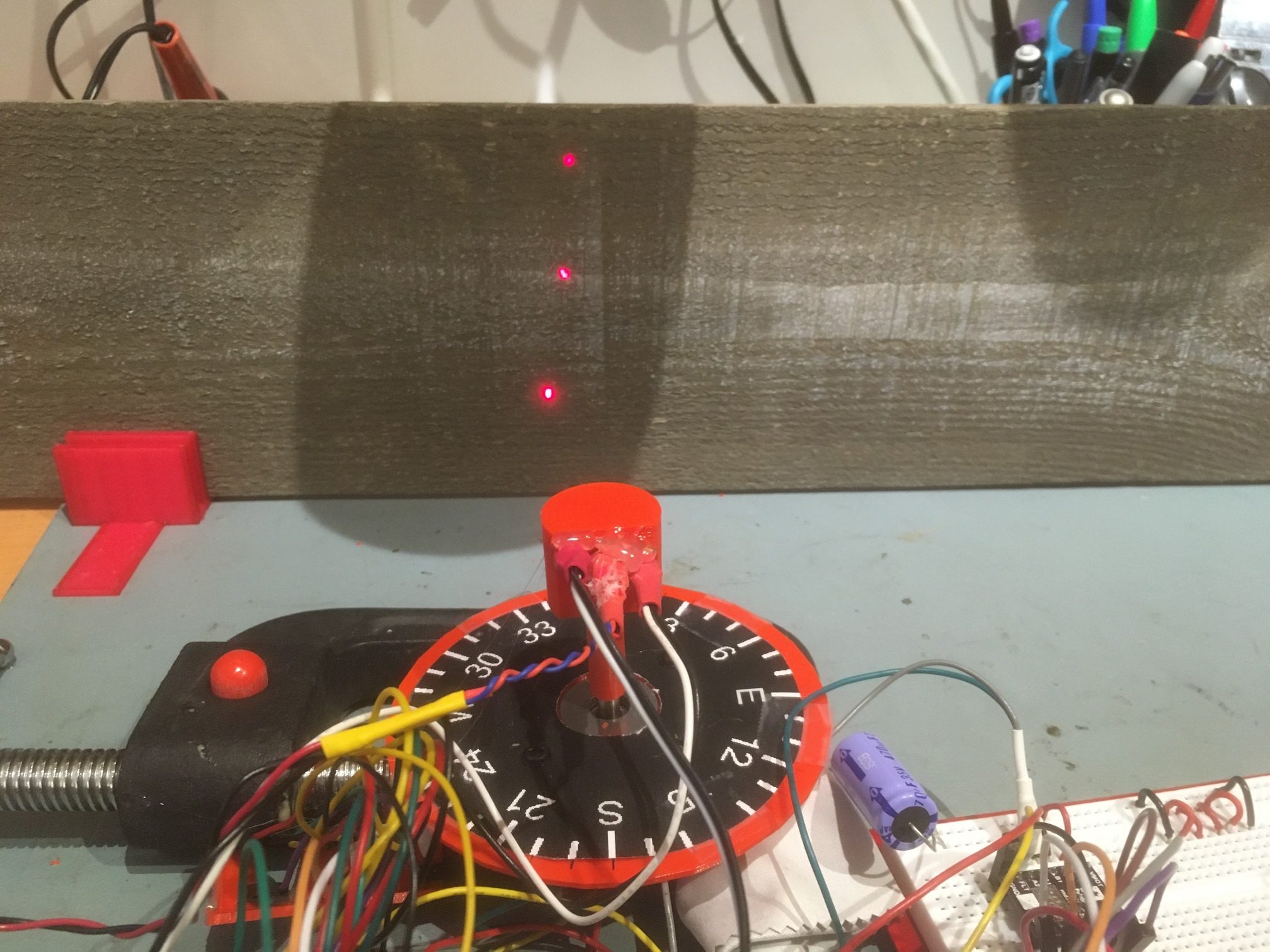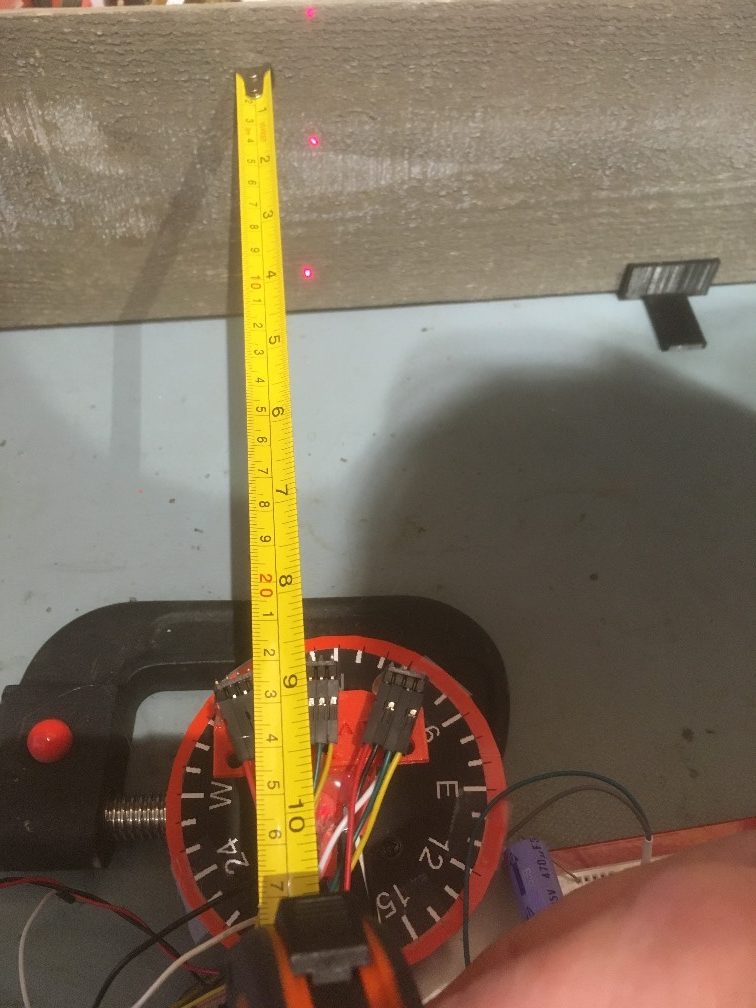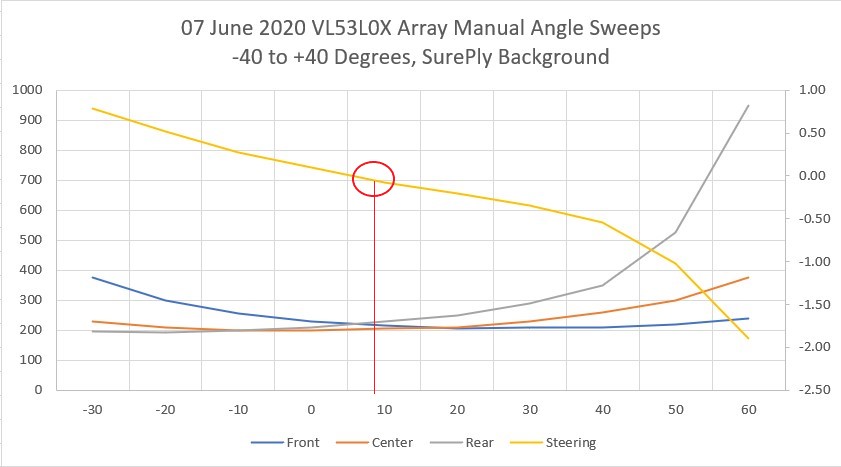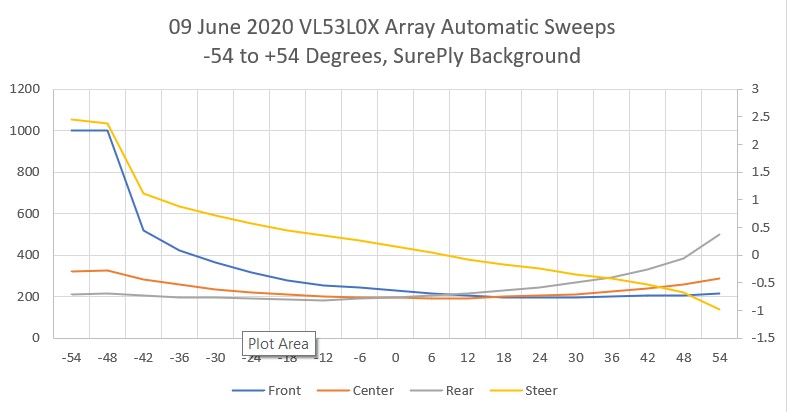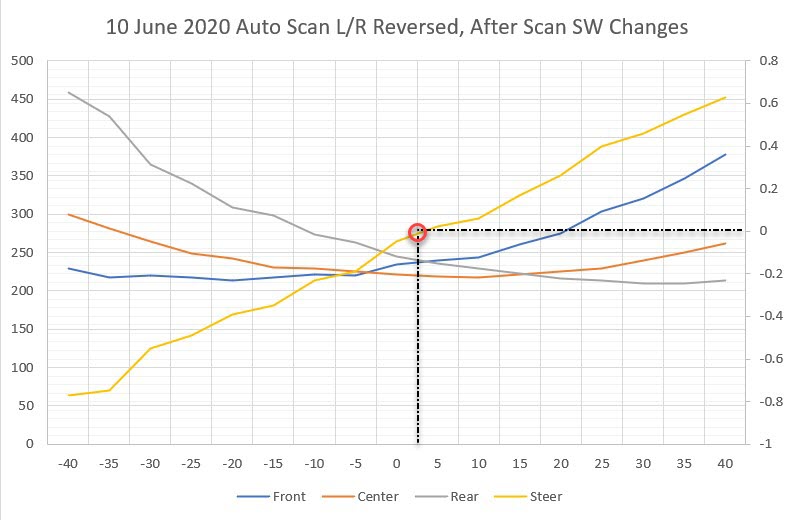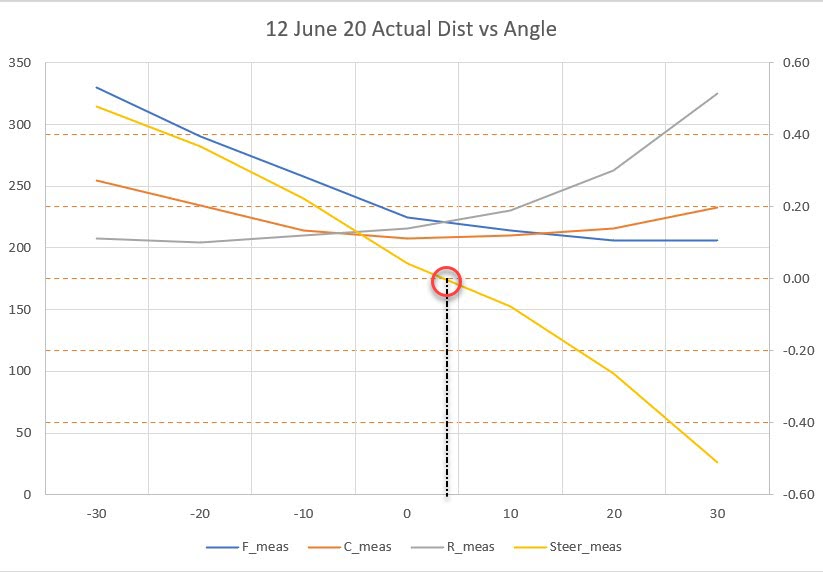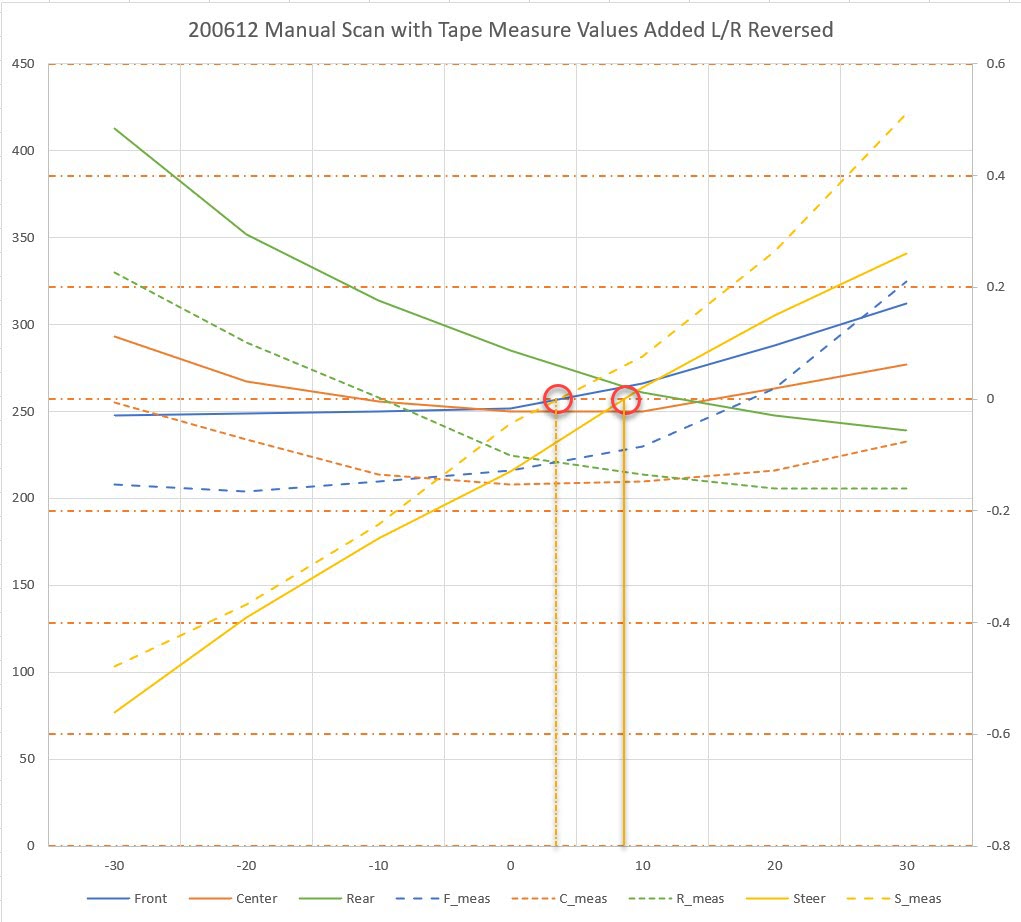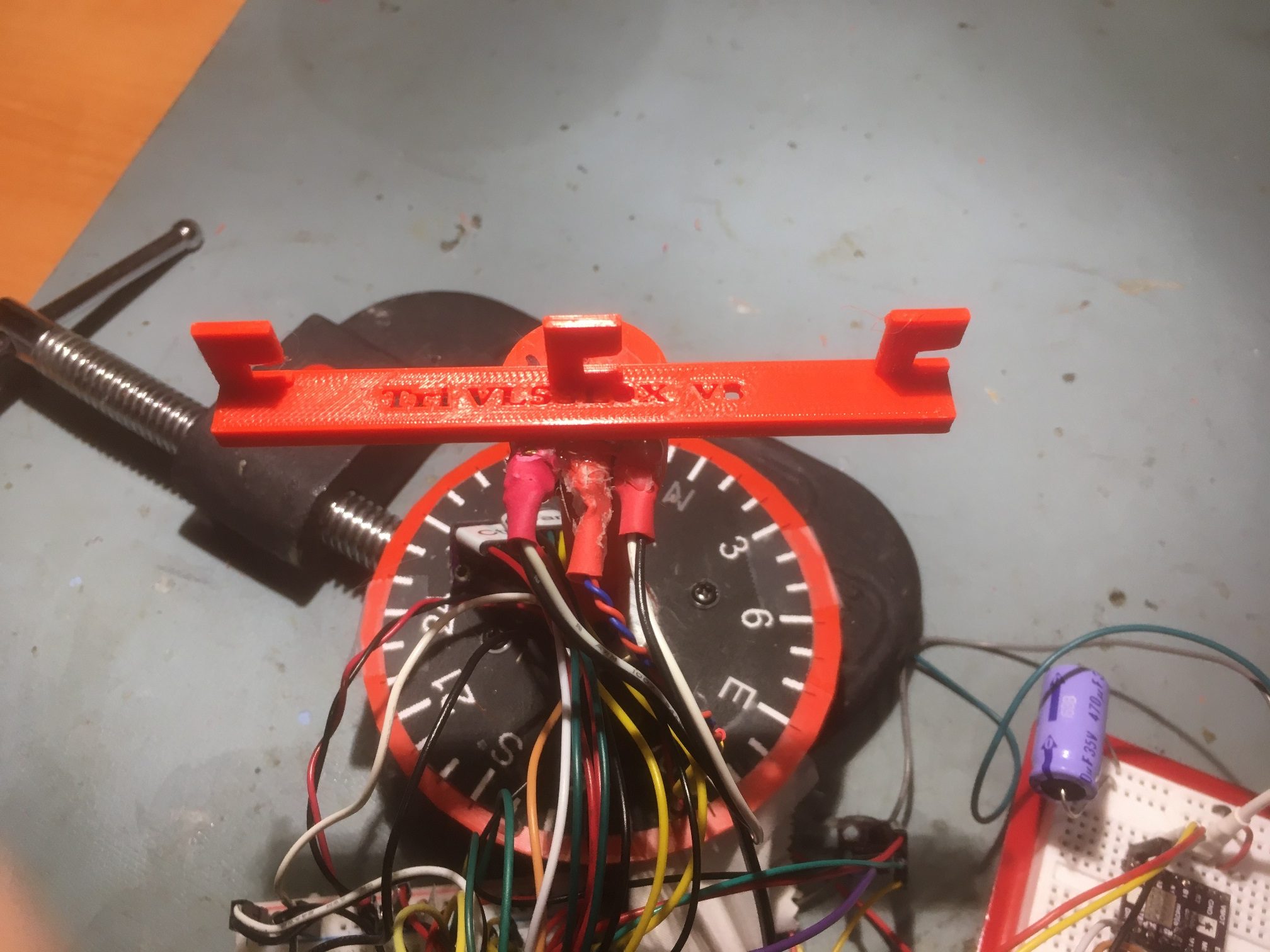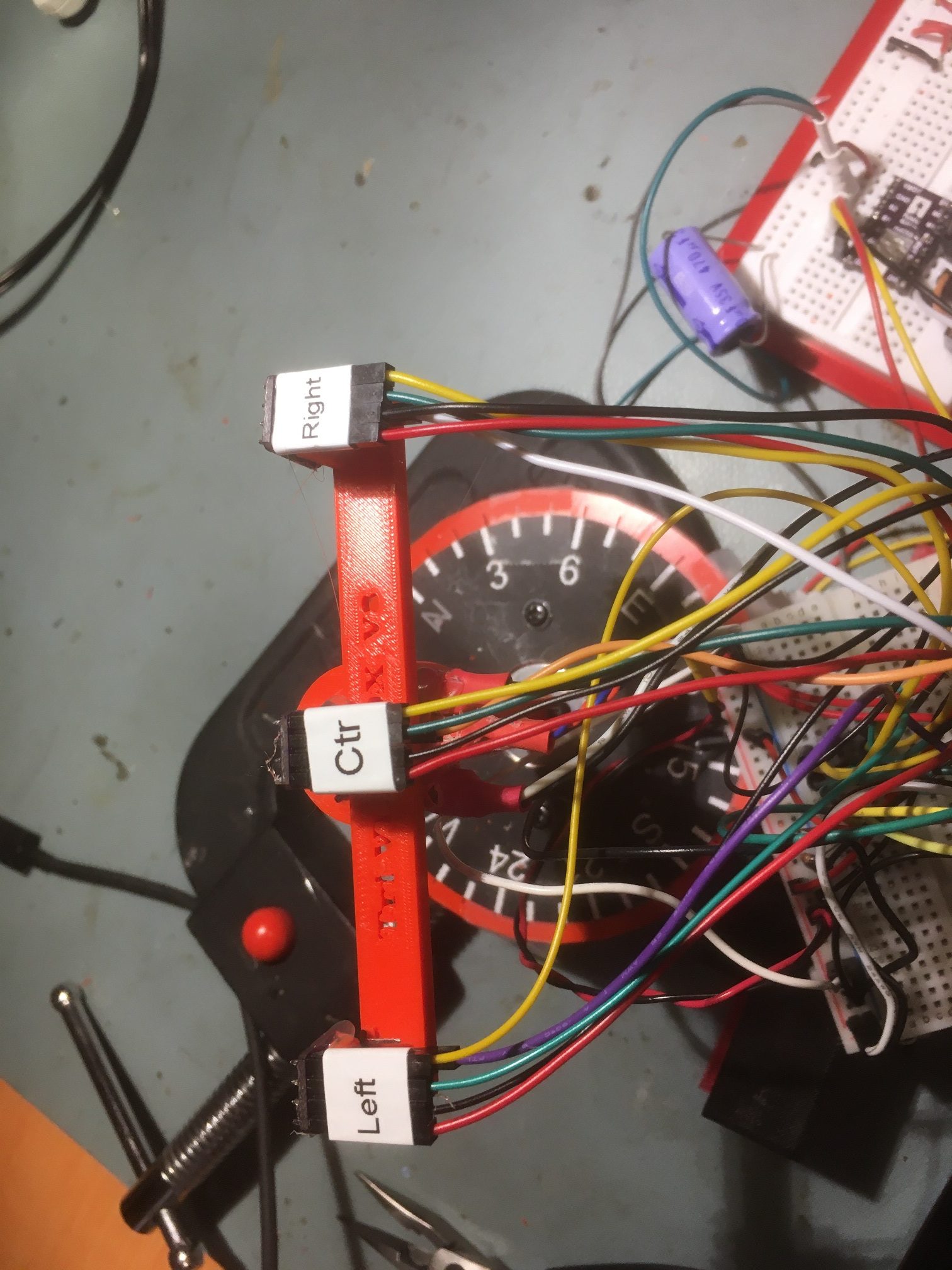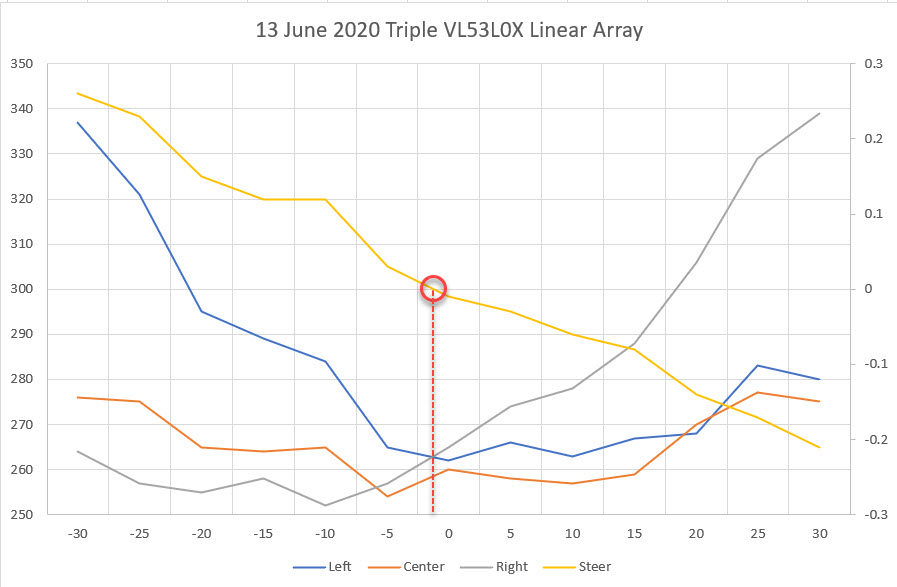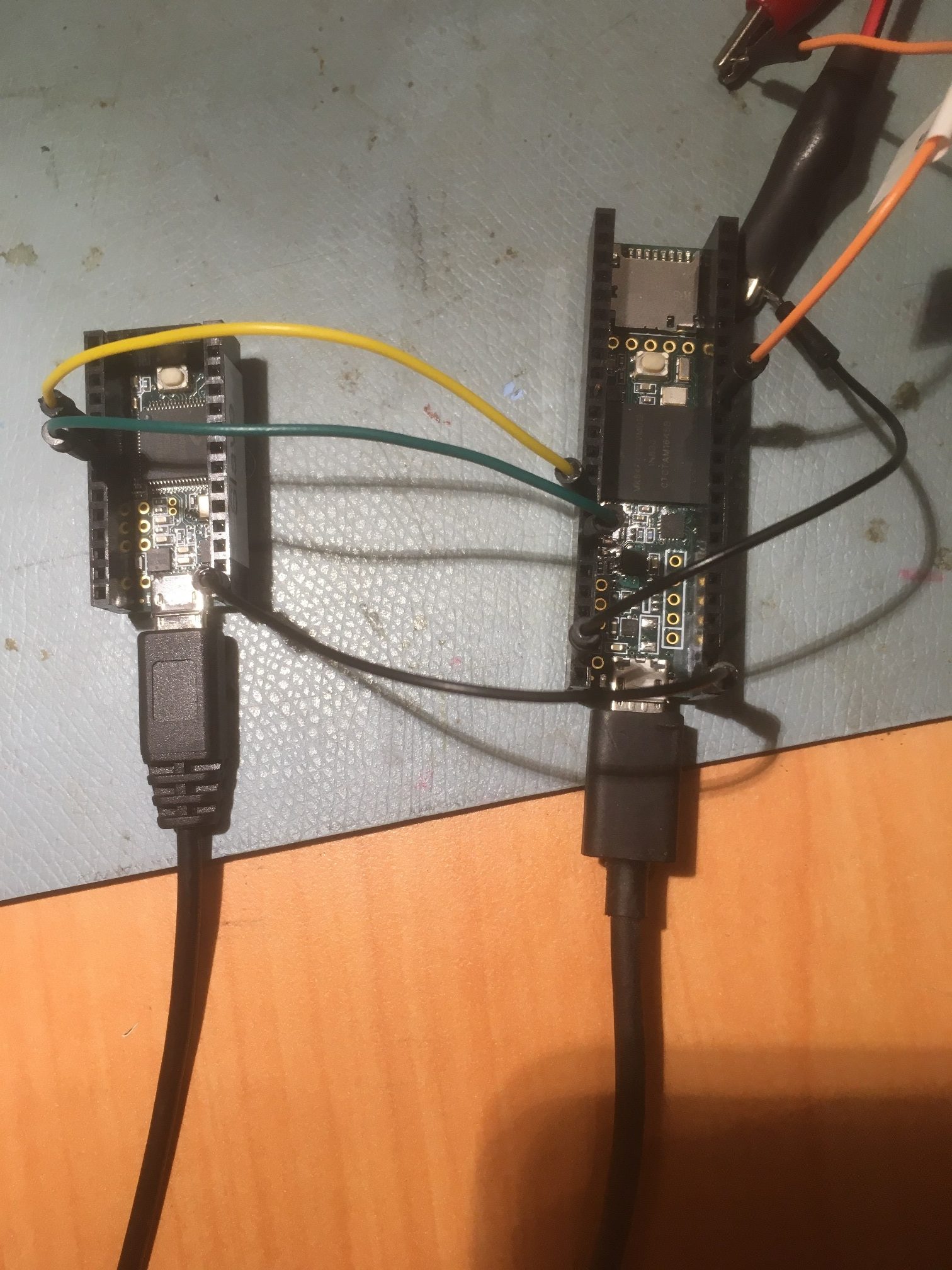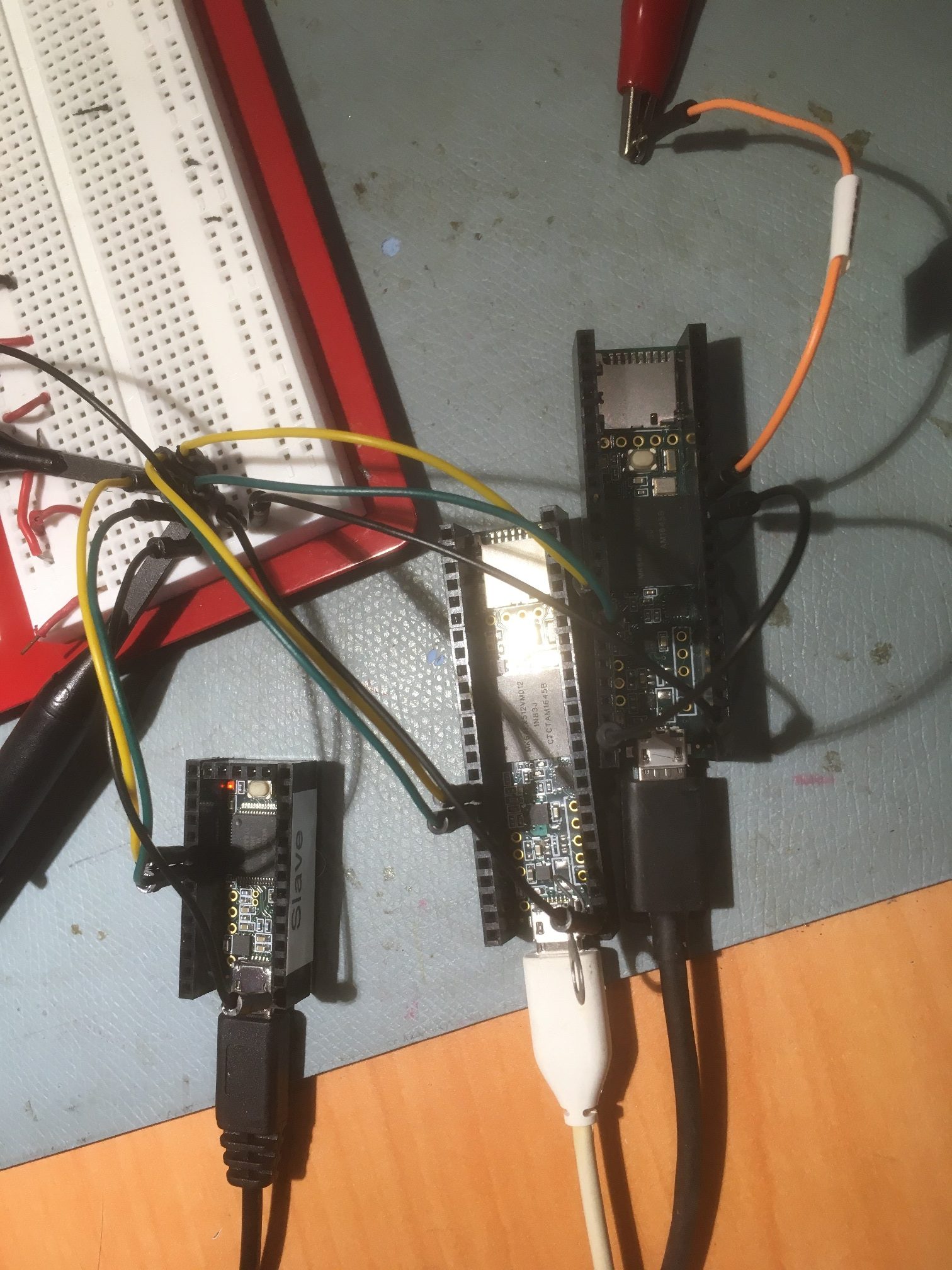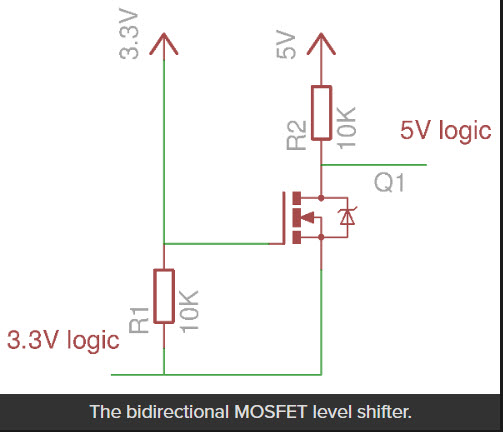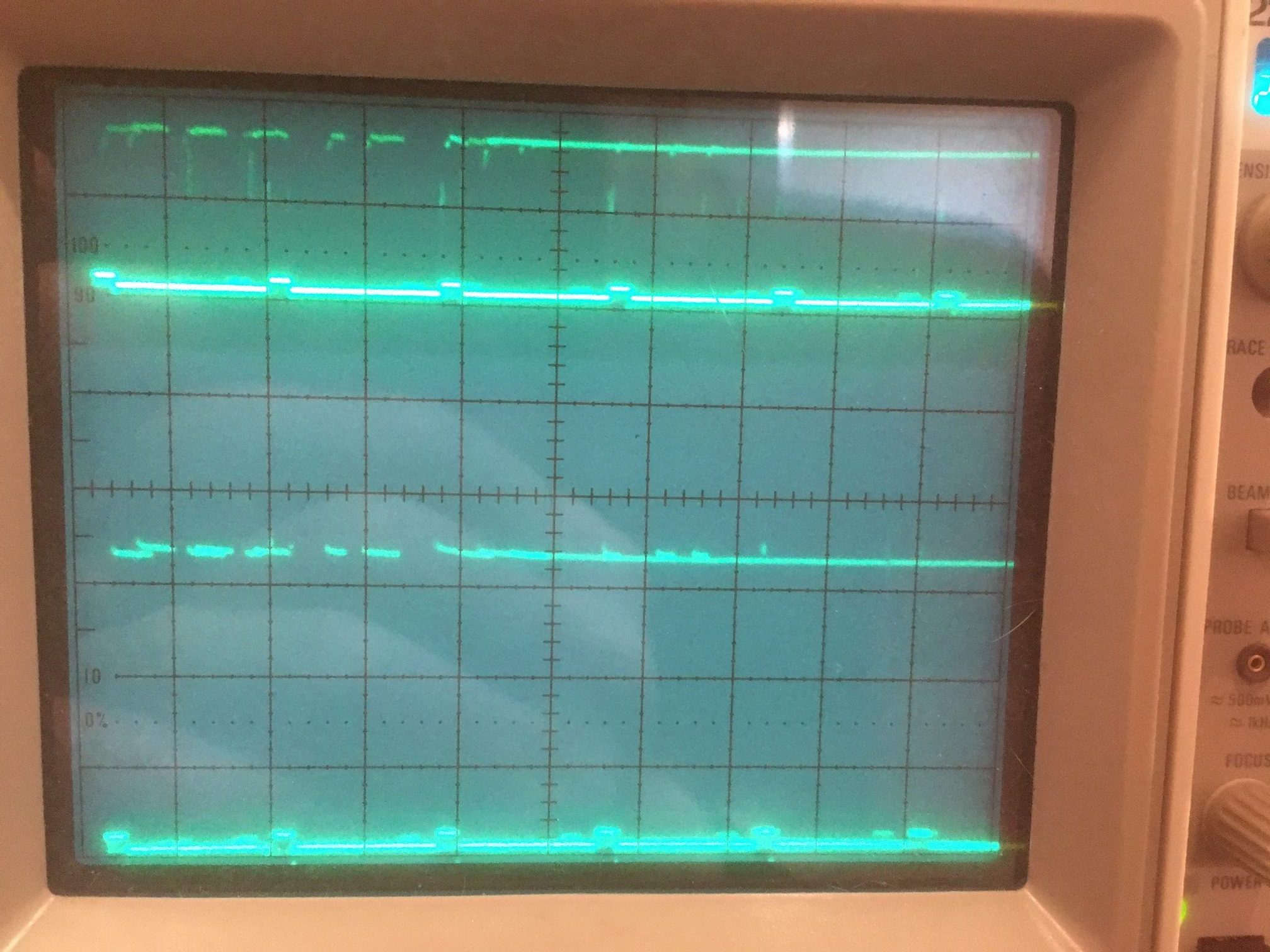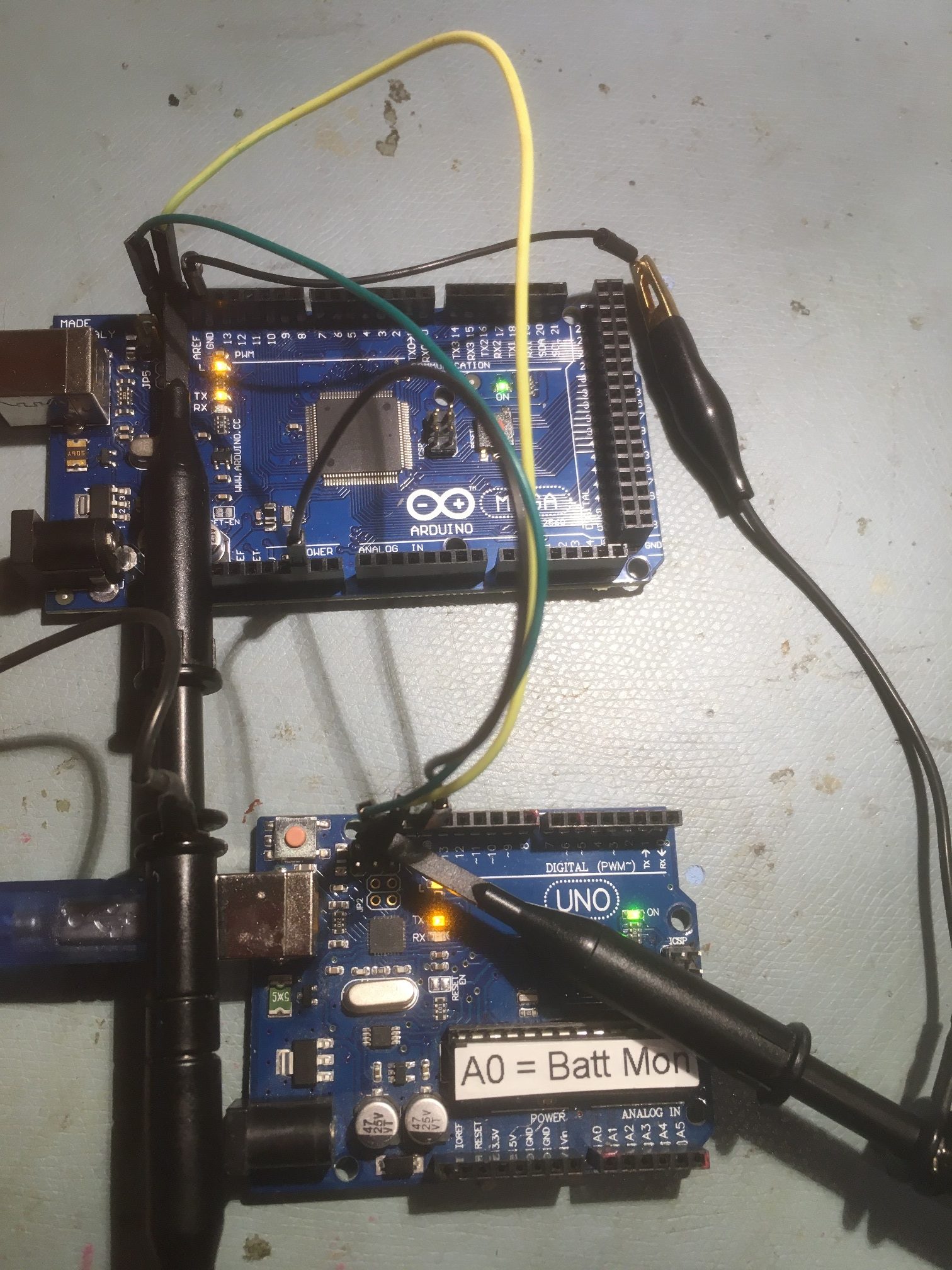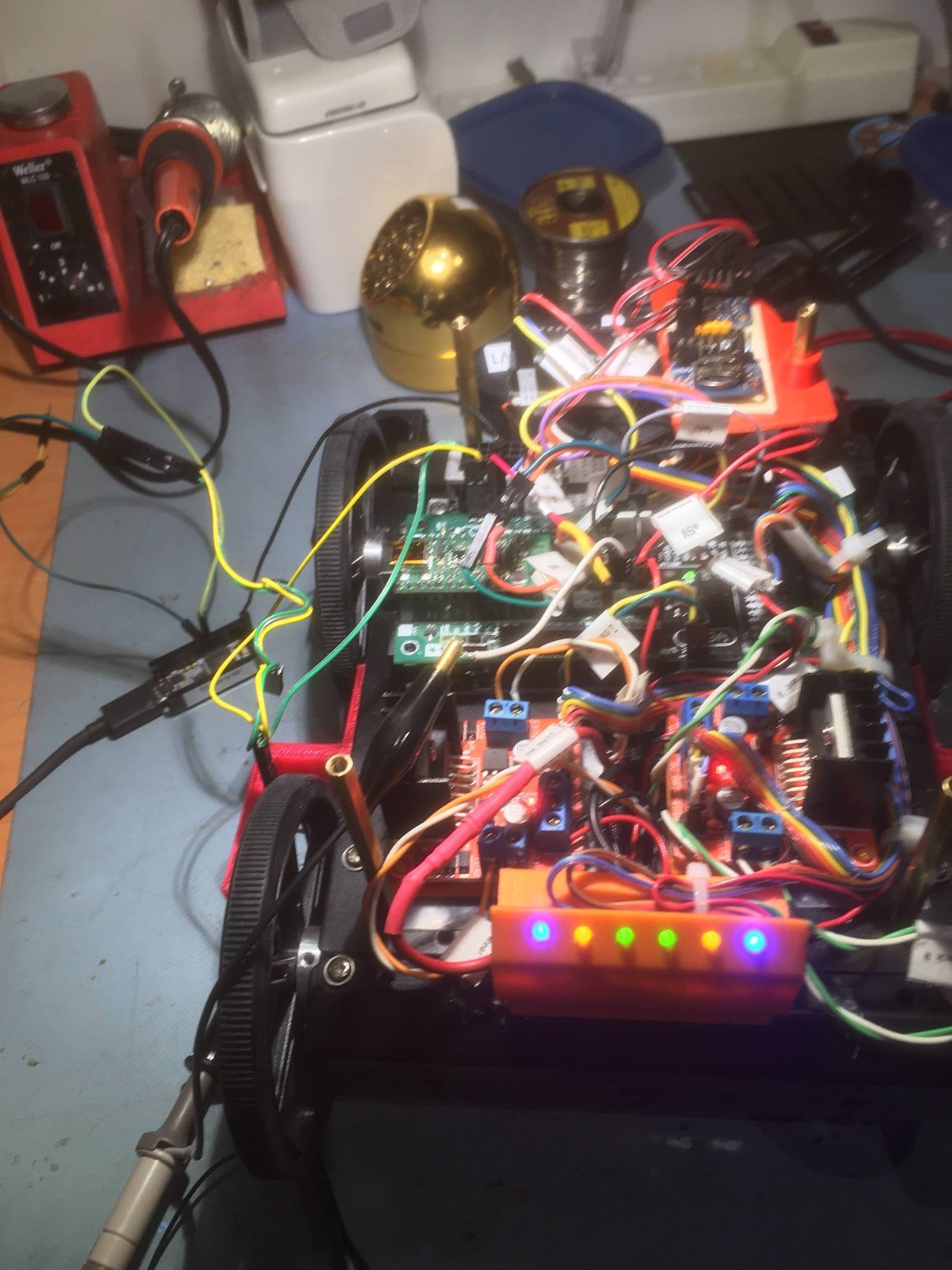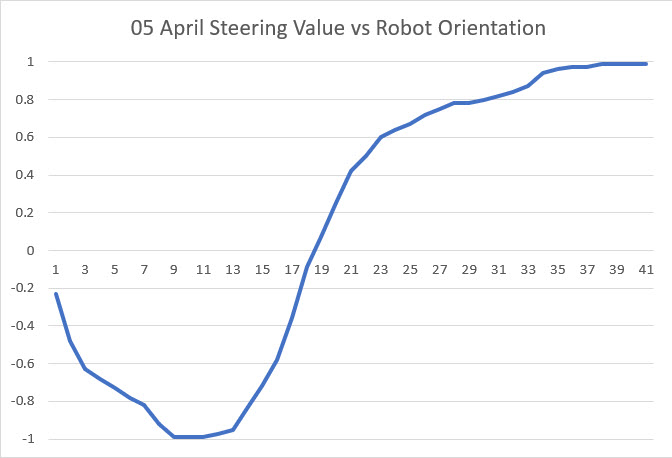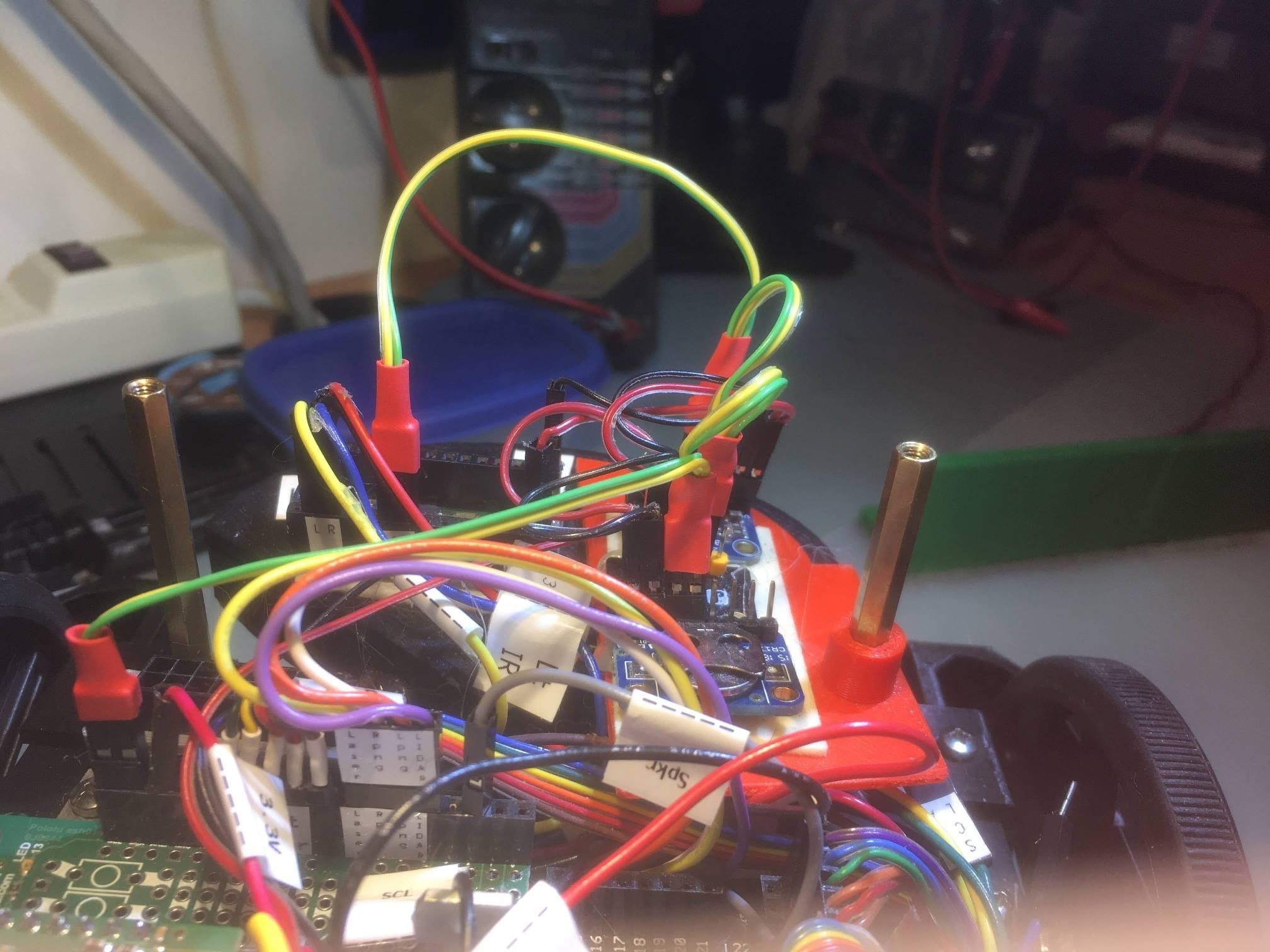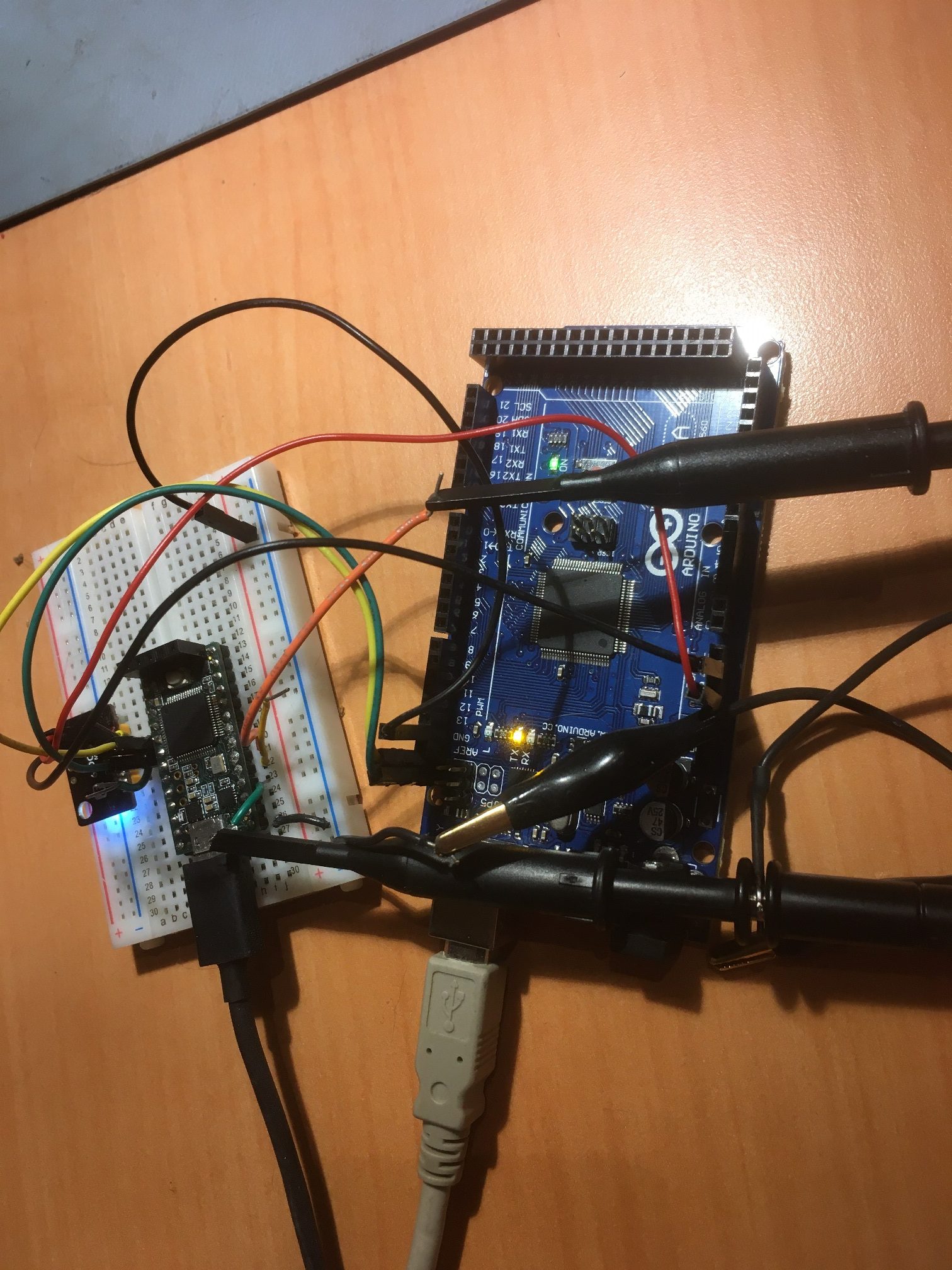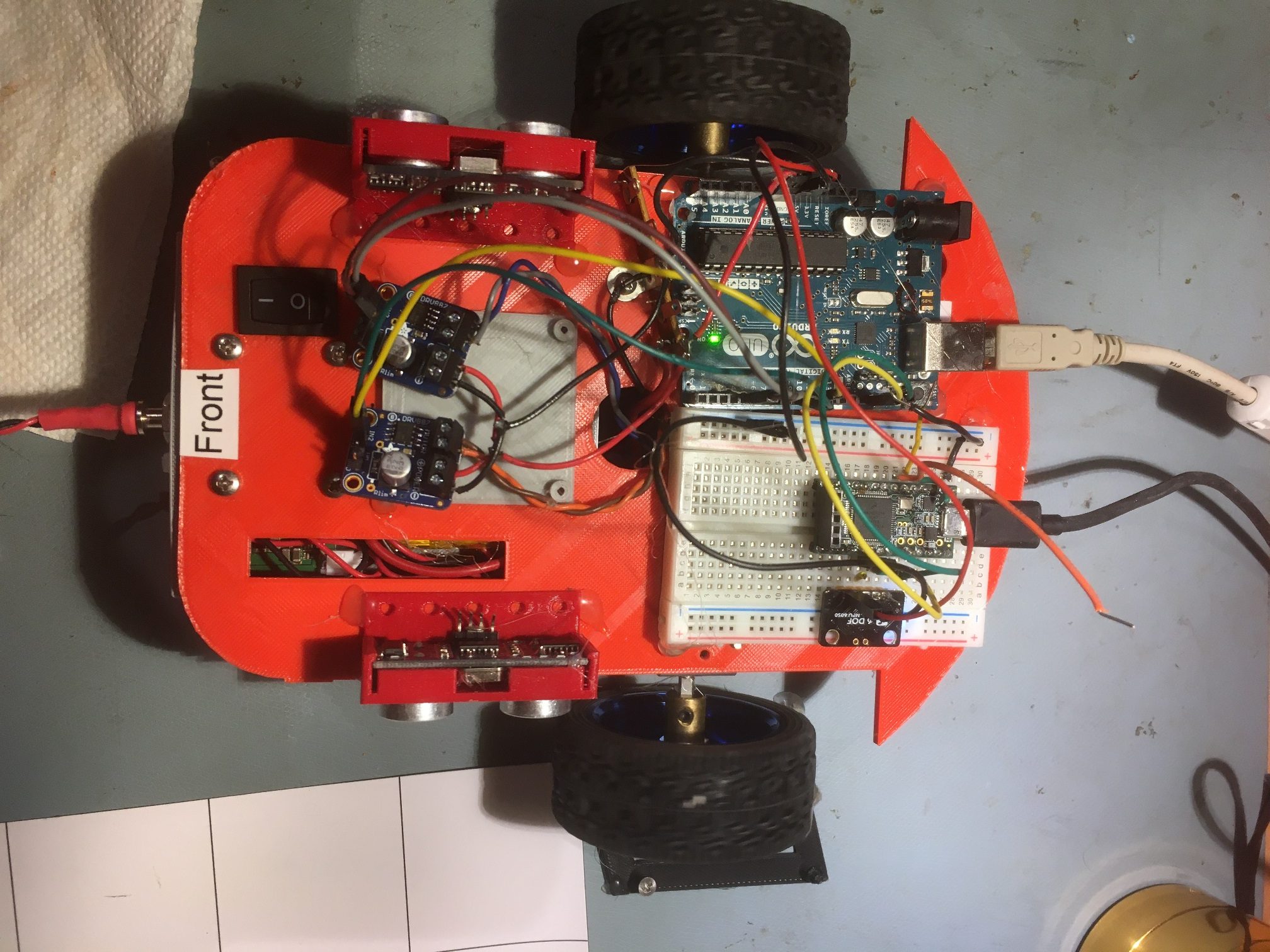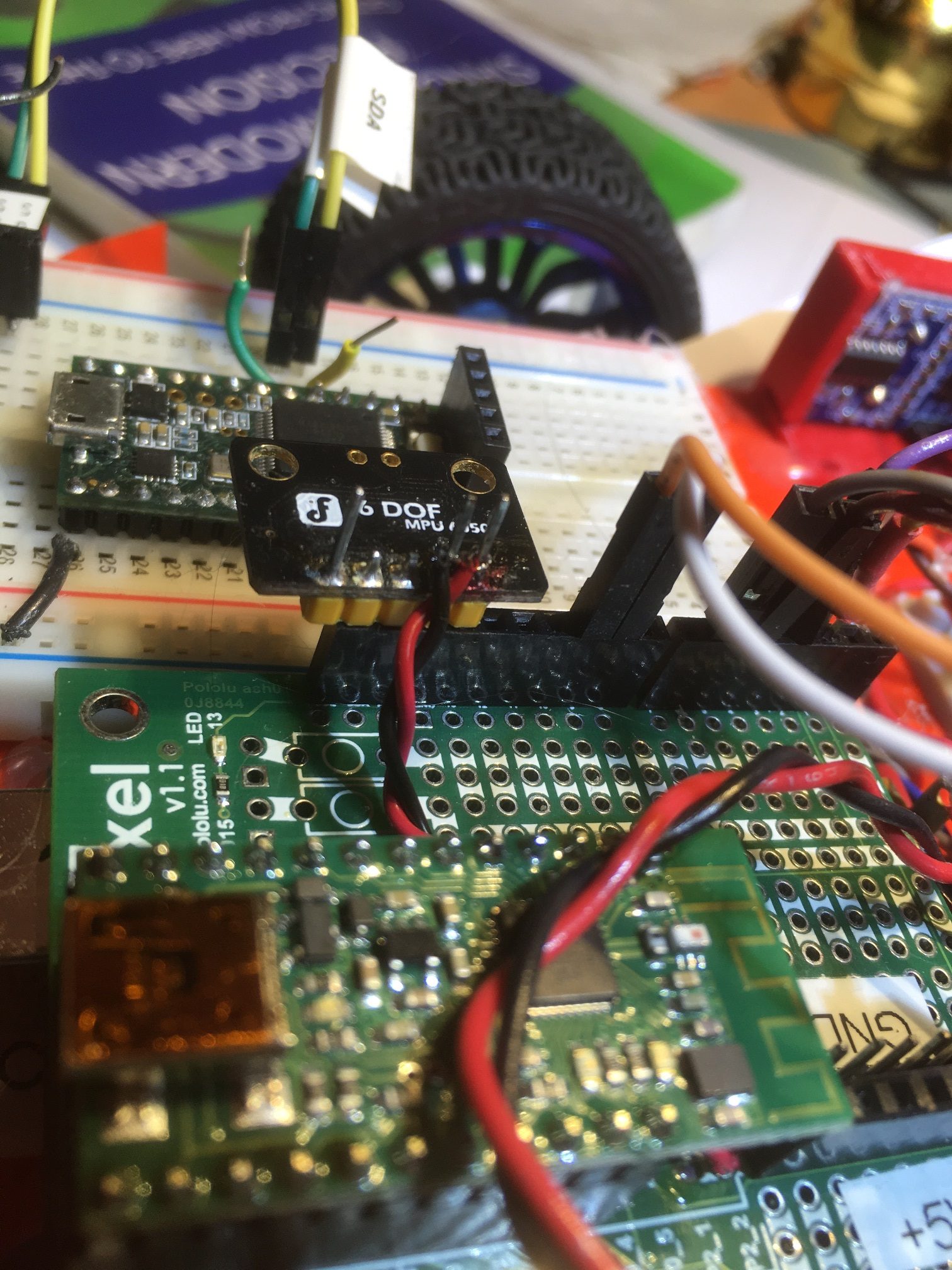/*
Name: Teensy_I2C_Sniffer_V11.ino
Created: 1/18/2020 10:55:55 AM
Author: FRANKNEWXPS15\Frank
*/
/* 'Notes:
A typical I2C sentence when communicating with a MPU6050 IMU module goes something like:
"I2C(68) wrote 1 byte to 75 - C0 Done."
"I2C(68) wrote 3 bytes to 72 - C0 0C 10 Done."
"I2C(68) read 5 bytes from 6A - C0 0C 10 14 03 Done."
To form a sentence, we need:
Device addr: 68 in the above examples
Read/Write direction
To/From register address: 75, 72 and 6A in the above examples
Data: C0, C0 0C 10, and C0 0C 10 14 03 in the above examples
number of bytes written/read: 1,3 & 5 in the above examples
Each I2C communication proceeds as follows (assuming a START from an IDLE condition):
A START or RESTART condition, denoted by SDA & SCL HIGH, followed by SDA LOW, SCL HIGH
A 7-bit device address, MSB first (0x8/0xC = 1, 0x0/0x4 = 0)
A R/W bit (0x8/0xC = read, 0x0/0x4 = write)
An ACK bit (0x8/0xC = NAK, 0x0/0x4 = ACK)
If the bus direction is WRITE, then
A register address for read/write
zero or more additional data bytes
Else (the bus direction is READ)
One or more additional data bytes
Endif
This version uses a fixed-size (2048 bytes) array instead of tonton81's circular buffer library.
To generalize for any I2C slave device rather than just the MPU6050 IMU, comment out the
"#define MPU6050_SPECIFIC line below. This will remove all MPU6050 specific code
*/
//#define MPU6050_SPECIFIC
#include <TimerOne.h> //needed for ISR
#ifdef MPU6050_SPECIFIC
#include "helper_3dmath.h" //Arduino\Libraries\i2cdevlib\Arduino\MPU6050\ needed to compute yaw from MPU6050 DMP packet
#endif
#define PARSE_LOOP_DEBUG
const uint16_t CAPTURE_ARRAY_SIZE = 2048;
const uint16_t VALID_DATA_ARRAY_SIZE = 2048;
const int WAITING_PRINT_INTERVAL_MSEC = 200;//interval timer for 'Waiting for data...' printout
#define MONITOR_OUT1 2 //so can monitor ISR activity with O'scope
#define MONITOR_OUT2 3 //so can monitor ISR activity with O'scope
#define MONITOR_OUT3 4 //so can monitor ISR activity with O'scope
#define SDA_PIN 18
#define SCL_PIN 19
#pragma region PROCESSING_VARIABLES
uint8_t devAddr;
uint8_t regAddr;
uint8_t databytes[2048]; //holds multiple databytes for later output sentence construction
uint16_t numbytes = 0; //number of data bytes extracted from data stream
int ACKNAKFlag; //can be negative
uint16_t databyte_idx = 0; //index into databyte_array
uint8_t killbuff[2]; //used to consume start/stop bytes
elapsedMillis mSecSinceLastWaitingPrint;
uint8_t valid_data[2048];
uint16_t numvalidbytes = 0; //number of valid bytes in this burst
uint16_t read_idx = 0; //pointer to next byte pair to be processed
//added for bus direction labels
enum BUSDIR
{
WRITE,
READ,
UNKNOWN = -1
} RWDir;
BUSDIR BusDir = BUSDIR::UNKNOWN;
#pragma endregion ProcVars
#pragma region ISR_SUPPORT
uint8_t raw_data[CAPTURE_ARRAY_SIZE]; //holds data captured from I2C bus
volatile uint16_t write_idx = 0;
volatile uint8_t current_portb = 0xFF;
volatile uint8_t last_portb = 0xFF;
volatile uint16_t mult0xCCount = 0;
const uint16_t MAX_IDLE_COUNT = 2500;
volatile bool bDone = false;
volatile bool bWaitingForStart = true;
volatile bool bIsData = true;
volatile bool bIsStart = false;
volatile bool bIsStop = false;
volatile uint8_t last_current;
#pragma endregion ISR Support
#ifdef MPU6050_SPECIFIC
//01/21/20 these forward declarations are required to force the preprocessor
//to handle #ifdef MPU6050_SPECIFIC properly
uint8_t dmpGetQuaternion(int16_t* data, const uint8_t* packet);
uint8_t dmpGetQuaternion(Quaternion* q, const uint8_t* packet);
uint8_t dmpGetYawPitchRoll(float* data, Quaternion* q, VectorFloat* gravity);
uint8_t dmpGetGravity(VectorFloat* v, Quaternion* q);
Quaternion q; // [w, x, y, z] quaternion container
VectorInt16 aa; // [x, y, z] accel sensor measurements
VectorInt16 aaReal; // [x, y, z] gravity-free accel sensor measurements
VectorInt16 aaWorld; // [x, y, z] world-frame accel sensor measurements
VectorFloat gravity; // [x, y, z] gravity vector
float ypr[3]; // [yaw, pitch, roll] yaw/pitch/roll container and gravity vector
float global_yawval = 0; //updated by GetIMUHeadingDeg()
#endif // MPU6050_SPECIFIC
void setup()
{
unsigned long now = millis();
Serial.begin(1); //rate value ignored
int idx = 0;
while (!Serial && (millis() - now) < 3000)
{
delay(500);
idx++;
}
Serial.printf("Serial available after %lu mSec\n", millis() - now);
pinMode(MONITOR_OUT1, OUTPUT);
digitalWrite(MONITOR_OUT1, LOW);
pinMode(MONITOR_OUT2, OUTPUT);
digitalWrite(MONITOR_OUT2, LOW);
pinMode(MONITOR_OUT3, OUTPUT);
digitalWrite(MONITOR_OUT3, LOW);
pinMode(SCL_PIN, INPUT);
pinMode(SDA_PIN, INPUT);
//reset port byte vars & start timer
last_portb = current_portb = 0;
write_idx = 0;
memset(raw_data, 255, CAPTURE_ARRAY_SIZE);
//PrintNextArrayBytes(raw_data, 255, 20);
Timer1.initialize(1); // run every mico second
Timer1.attachInterrupt(capture_data);
mSecSinceLastWaitingPrint = 0;
}
//-------------------------------------------------------------------------------
//-------------------------------- ISR ------------------------------------
//-------------------------------------------------------------------------------
FASTRUN void capture_data()
//void capture_data()
{
last_portb = current_portb;
current_portb = GPIOB_PDIR & 12; //reads state of SDA (18) & SCL (19) at same time
if (!bDone && last_portb != current_portb)
{
mult0xCCount = 0; //reset IDLE counter
digitalWriteFast(MONITOR_OUT1, HIGH);
//01/17/20: joepasquariello suggestion
last_current = (last_portb << 4) | (current_portb);
bIsStart = (last_current == 0xC4);
bIsStop = (last_current == 0x4C);
bIsData = (last_current == 0x04) || (last_current == 0x8C);
if (bIsStart) //START
{
digitalWriteFast(MONITOR_OUT2, HIGH);
if (bWaitingForStart)
{
digitalWriteFast(MONITOR_OUT3, HIGH); //start of entire capture
bWaitingForStart = false;
}
}
else if (bIsStop) //STOP
{
digitalWriteFast(MONITOR_OUT2, LOW);
}
if (!bWaitingForStart && (bIsData || bIsStart || bIsStop))
{
//digitalWriteFast(MONITOR_OUT3, HIGH);
raw_data[write_idx] = last_portb;
write_idx++;
raw_data[write_idx] = current_portb;
write_idx++;
if (write_idx >= CAPTURE_ARRAY_SIZE)
{
bDone = true;
digitalWriteFast(MONITOR_OUT3, LOW);
}
}
digitalWriteFast(MONITOR_OUT1, LOW);
}
else if (!bDone && mult0xCCount < MAX_IDLE_COUNT && last_portb == 0xc && current_portb == 0xc)
{
mult0xCCount++;
if (mult0xCCount >= MAX_IDLE_COUNT)
{
digitalWriteFast(MONITOR_OUT3, LOW);
bDone = true;
}
}
}
//-------------------------------------------------------------------------------
//-------------------------------- END ISR ---------------------------------
//-------------------------------------------------------------------------------
void loop()
{
if (bDone)
{
if (write_idx > 14)
{
//OK, we have some data to process. IDLE detection must have been EOM
Timer1.stop();
unsigned long startMsec = millis();
//Serial.printf("%lu\t %d\t", millis(), write_idx);
//PrintNextArrayBytes(raw_data, 0, 50);
//Serial.printf(" - %lu\n", millis());
uint16_t numprocessed = DecodeAndPrintValidData(raw_data); //decode and print everything captured so far
unsigned long endMsec = millis();
Serial.printf("%lu: processed = %d elements in %lu mSec\n\n", startMsec, numprocessed, endMsec-startMsec);
Timer1.start();
}
read_idx = 0;
bDone = false;
mult0xCCount = 0;
write_idx = 0;
bWaitingForStart = true;
}
else
{
//no data to process, but don't blow prints out every mSec...
if (mSecSinceLastWaitingPrint > WAITING_PRINT_INTERVAL_MSEC)
{
mSecSinceLastWaitingPrint -= WAITING_PRINT_INTERVAL_MSEC;
Serial.printf("%lu: Waiting for Data...\n", millis());
}
}
}
void PrintNextArrayBytes(uint8_t* data, uint16_t startidx, uint16_t numbytes)
{
Serial.printf("%d bytes starting at %d: ", numbytes, startidx);
for (uint16_t i = 0; i < numbytes; i++)
{
Serial.printf("%x ", data[i + startidx]);
}
}
uint16_t DecodeAndPrintValidData(byte* data)
{
//Purpose: decode and print I2C conversation held in raw_data array
//Inputs:
// cb = 2048 element FIFO
//Outputs:
// returns number of bytes processed, or -1 for failure
// outputs structured I2C sentence to serial monitor
//Plan:
// Step1: Cull out invalid bytes
// Step2: Determine if there is anything to do (have to have more than one transition in FIFO)
// Step3: Parse transitions into I2C sentence structure
// Step4: Output sentence to serial monitor
memset(valid_data, 0, VALID_DATA_ARRAY_SIZE);
#ifdef PARSE_LOOP_DEBUG
PrintNextArrayBytes(valid_data, 0, 20); //print out first 20 bytes for verification
#endif
numvalidbytes = RemoveInvalidBytes(raw_data, valid_data);
#ifdef PARSE_LOOP_DEBUG
Serial.printf("Removed %d invalid bytes, leaving %d remaining\n", write_idx + 1 - numvalidbytes, numvalidbytes);
PrintNextArrayBytes(valid_data, 0, numvalidbytes); //print out first 20 bytes of valid_data array
#endif
if (numvalidbytes < 2)
{
return 0;
}
while (read_idx < numvalidbytes)
{
#ifdef PARSE_LOOP_DEBUG
Serial.printf("At top of while (read_idx < numvalidbytes): read_idx = %d\n", read_idx);
Serial.printf("Next two bytes in valid_data are %x, %x\n", valid_data[read_idx], valid_data[read_idx + 1]);
#endif
//Find a START sequence (0xC followed by 0x4)
while (!IsStart(valid_data, read_idx) && read_idx < numvalidbytes)
{
//Serial.printf("looking for start...\n");
read_idx++;
}
//at this point, read_idx should point to next valid byte pair
#ifdef PARSE_LOOP_DEBUG
Serial.printf("Start sequence found at %d\n", read_idx - 2);
//PrintNextFIFOBytes(valid_data, 20);
#endif
if (numvalidbytes - read_idx > 14)//14 entries required for 7-bit address
{
//Get 7-bit device address
devAddr = Get7BitDeviceAddr(valid_data, read_idx);
#ifdef PARSE_LOOP_DEBUG
Serial.printf("devAddr = %x\n", devAddr);
#endif
}
else
{
#ifdef PARSE_LOOP_DEBUG
Serial.printf("ran out of data at readidx = %d - exiting!\n", read_idx);
#endif
break;
}
//get read/write flag 1 = Read, 0 = Write, -1 = error
BusDir = (BUSDIR)GetReadWriteFlag(valid_data, read_idx);
#ifdef PARSE_LOOP_DEBUG
Serial.printf("BusDir = %s\n", ((BusDir == BUSDIR::WRITE) ? "WRITE" : "READ"));
//PrintNextFIFOBytes(valid_data, 20);
#endif
//get ACK/NAK flag
ACKNAKFlag = GetACKNAKFlag(valid_data, read_idx);
numbytes = GetDataBytes(valid_data, read_idx, databytes); //terminates on a START, but the start bytes are not consumed
#ifdef PARSE_LOOP_DEBUG
Serial.printf("Got %d bytes from GetDataBytes() --> ", numbytes);
for (size_t i = 0; i < numbytes; i++)
{
Serial.printf(" %x ", databytes[i]);
}
Serial.printf("\n");
//PrintNextFIFOBytes(cb_trans, 20);
#endif
//If the bus direction is WRITE, then extract
// A register address for read / write
// zero or more additional data bytes
if (BusDir == BUSDIR::WRITE)
{
regAddr = databytes[0];
#ifdef PARSE_LOOP_DEBUG
Serial.printf("regAddr = %x, read_idx = %d\n", regAddr, read_idx);
#endif
//check for additional data
if (numbytes > 1)
{
#ifdef PARSE_LOOP_DEBUG
Serial.printf("Additional data found!\n");
for (size_t i = 0; i < numbytes; i++)
{
Serial.printf("data[%d] = %x\n", i, databytes[i]);
}
#endif
//1st byte is register addr, subsequent bytes are data
OutputFormattedSentence(BusDir, devAddr, regAddr, numbytes, databytes, 1);
}
}
else //all bytes are data
{
#ifdef PARSE_LOOP_DEBUG
Serial.printf("In data block: got %d bytes of data\n", numbytes);
for (size_t i = 0; i < numbytes; i++)
{
Serial.printf("data[%d] = %x\n", i, databytes[i]);
}
#endif
OutputFormattedSentence(BusDir, devAddr, regAddr, numbytes, databytes, 0);
}
#ifdef PARSE_LOOP_DEBUG
Serial.printf("At end of while (read_idx < numvalidbytes): read_idx = %d\n", read_idx);
#endif
}//while (read_idx < numvalidbytes)
return numvalidbytes;
}
#pragma region Support Functions
bool IsStart(byte* data, uint16_t& readidx)
{
bool result = false;
//Serial.printf("IsStart[%d] = %x, IsStart[%d] = %x\n",
// readidx, data[readidx], readidx + 1, data[readidx + 1]);
if (data[readidx] == 0xC && data[readidx + 1] == 0x4)
{
result = true;
readidx += 2; //bump to next byte pair
}
return result;
}
bool IsStop(byte* data, uint16_t& readidx)
{
bool result = false;
//Serial.printf("IsStop[%d] = %x, IsStop[%d] = %x\n",
//readidx, data[readidx], readidx + 1, data[readidx + 1]);
if (data[readidx] == 0x4 && data[readidx + 1] == 0xC)
{
result = true;
readidx += 2; //bump to next byte pair
}
return result;
}
uint8_t Get7BitDeviceAddr(byte* data, uint16_t& readidx)
{
//Purpose: Construct a 7-bit address starting from dataidx
//Inputs:
// data = pointer to valid data array
// readidx = starting index of 7-bit address sequence (MSB first)
//Outputs:
// returns the address as an 8-bit value with the MSB = 0, or 0x0 if unsuccessful
// dataidx = pointer to next data entry
//Plan:
// Step1: Convert a pair of data entries into a 0 or 1
// Step2: Add the appropriate value to an ongoing sum
// Step3: return the total.
//Notes:
// A '0' is coded as a 0x0 followed by a 0x4
// A '1' is coded as a 0x8 followed by a 0xC
uint8_t devAddr = 0x0; //failure return value
//Serial.printf("Get7BitDeviceAddr: readidx = %d\n",readidx);
//devAddr is exactly 7 bits long, so 8 bits with MSB = 0
for (size_t i = 0; i < 7; i++)
{
if (data[readidx] == 0x0 && data[readidx + 1] == 0x4)
{
readidx += 2; //advance the pointer, but don't add to sum
}
else if (data[readidx] == 0x8 && data[readidx + 1] == 0xC)
{
//Serial.printf("Get7BitDeviceAddr: '1' found at i = %d, adding %x to devAddr to get %x\n",
// i, 1 << (7 - i), devAddr + (1 << (7-i)));
readidx += 2; //advance the pointer
devAddr += (1 << (7 - i)); //add 2^(7-i) to sum
}
}
devAddr = devAddr >> 1; //divide result by 2 to get 7-bit addr from 8 bits
return devAddr;
}
int Get8BitDataByte(byte* data, uint16_t& readidx)
{
//Purpose: Construct a 8-bit data byte starting from dataidx
//Inputs:
// data = pointer to valid data array
// readidx = starting index of 8-bit data byte (MSB first)
//Outputs:
// returns the address as an 8-bit value, or 0x0 if unsuccessful
// dataidx = pointer to next data entry
//Plan:
// Step1: Convert a pair of data entries into a 0 or 1
// Step2: Add the appropriate value to an ongoing sum
// Step3: return the total.
//Notes:
// A '0' is coded as a 0x0 followed by a 0x4
// A '1' is coded as a 0x8 followed by a 0xC
// 12/29/19 - changed return val to int, so can return -1 when a 'short byte' is detected
int dataval = 0x0; //failure return value
#ifdef GET_8BIT_DATABYTE_DEBUG
Serial.printf("Get8BitDataByte: data[%d] = %x, data[%d] = %x\n",
readidx, data[readidx], readidx + 1, data[readidx + 1]);
#endif
//8 bits with MSB = 0
int numbytes = 0;
for (size_t i = 0; i < 8; i++)
{
if (data[readidx] == 0x0 && data[readidx + 1] == 0x4)
{
readidx += 2; //advance the pointer, but don't add to sum
numbytes++;
}
else if (data[readidx] == 0x8 && data[readidx + 1] == 0xC)
{
#ifdef GET_8BIT_DATABYTE_DEBUG
Serial.printf("Get8BitDataByte: '1' found at i = %d, adding %x to devAddr to get %x\n",
i, 1 << (7 - i), dataval + (1 << (7 - i)));
#endif
readidx += 2; //advance the pointer
dataval += (1 << (7 - i)); //add 2^(8-i) to sum
numbytes++;
}
}
#ifdef GET_8BIT_DATABYTE_DEBUG
Serial.printf("Get8BitDataByte: numbytes = %d\n", numbytes);
#endif
if (numbytes != 8)
{
dataval = -1; //error return value
}
return dataval;
}
int GetReadWriteFlag(byte* data, uint16_t& readidx)
{
//Purpose: decode R/W byte pair
//Inputs:
// data = pointer to valid data array
// readidx = index into data to start of R/W byte pair
//Outputs:
// readidx = if successful, points to next byte pair in data
// returns 1 for Read (0x8/0xC), 0 for Write (0x0/0x4), -1 for failure
//Notes:
//
//Serial.printf("GetReadWriteFlag: readidx = %d, data[readidx] = %x, data[readidx+1]= %x\n",
// readidx, data[readidx], data[readidx + 1]);
int result = 0;
if (data[readidx] == 0x8 && data[readidx + 1] == 0xC)
{
result = 1; //read detected
readidx += 2; //point to next byte pair
}
else if (data[readidx] == 0x0 && data[readidx + 1] == 0x4)
{
result = 0; //write detected
readidx += 2; //point to next byte pair
}
else
{
result = -1; //failed to detect read or write
}
return result;
}
int GetACKNAKFlag(byte* data, uint16_t& readidx)
{
//Purpose: decode ACK/NAK byte pair
//Inputs:
// data = pointer to valid data array
// readidx = index into data to start of ACK/NAK byte pair
//Outputs:
// readidx = if successful, points to next byte pair in data
// returns 1 for NAK (0x8/0xC), 0 for ACK (0x0/0x4), -1 for failure
//Notes:
//
//Serial.printf("GetACKNAKFlag: readidx = %d, data[readidx] = %x, data[readidx+1]= %x\n",
// readidx, data[readidx], data[readidx + 1]);
int result = 0;
if (data[readidx] == 0x8 && data[readidx + 1] == 0xC)
{
result = 1; //NAK detected
readidx += 2; //point to next byte pair
}
else if (data[readidx] == 0x0 && data[readidx + 1] == 0x4)
{
result = 0; //ACK detected
readidx += 2; //point to next byte pair
}
else
{
result = -1; //failed to detect ACK or NAK
}
return result;
}
int GetDataBytes(uint8_t* data, uint16_t& readidx, uint8_t* databytes)
{
//Notes:
// 01/01/2020: removed databyteidx from sig - always starts at zero
uint16_t numbytes = 0;
uint16_t databyte_idx = 0;
bool StartFlag = false;
bool StopFlag = false;
do
{
int dataval = Get8BitDataByte(data, readidx);
//watch out for 'short byte' reads
if (dataval >= 0)
{
uint8_t databyte = (uint8_t)dataval;
databytes[databyte_idx] = databyte;
databyte_idx++;
numbytes++;
}
ACKNAKFlag = GetACKNAKFlag(data, readidx);
StartFlag = IsStart(data, readidx);
StopFlag = IsStop(data, readidx);
#ifdef PARSE_LOOP_DEBUG
Serial.printf("IsStart returned %d, IsStop returned %d, dataidx = %d\n",
StartFlag, StopFlag, readidx);
#endif
} while (!StartFlag && !StopFlag && readidx < numvalidbytes);
readidx -= 2;//back readidx up so loop top is positioned correctly.
return numbytes;
}
void OutputFormattedSentence(int RW, uint8_t dev, uint8_t reg, uint8_t numbytes, uint8_t* bytearray, uint16_t startidx)
{
Serial.printf("%lu I2C(%x) %s %d bytes %s %x... ",
millis(), dev, (RW == 0 ? "writing" : "reading"), numbytes - startidx, (RW == 0 ? "to" : "from"), reg);
//for (size_t i = startidx; i < numbytes; i++)
//{
// Serial.printf("%x ", bytearray[i]);
//}
//Serial.printf(". Done\n");
#ifdef MPU6050_SPECIFIC
//01/18/20 experiment to decode 28-byte packet into yaw value
if (numbytes == 28)
{
dmpGetQuaternion(&q, bytearray);
dmpGetGravity(&gravity, &q);
dmpGetYawPitchRoll(ypr, &q, &gravity);
//compute the yaw value
global_yawval = ypr[0] * 180 / M_PI;
Serial.printf("yawval = %3.2f\n", global_yawval);
}
else
{
Serial.printf(". Done\n");
}
#endif // MPU6050_SPECIFIC
}
uint16_t RemoveInvalidBytes(uint8_t* rawdata, uint8_t* validdata)
{
uint16_t numvalid = 0;
uint16_t valididx = 0;
//Serial.printf("raw data array contains %d bytes\n", write_idx + 1);
//PrintNextArrayBytes(raw_data, 0, 20);
//OK, now go back through the array, excising invalid sequences
for (uint16_t rawidx = 0; rawidx < write_idx;/*rawidx incremented internally*/)
{
uint8_t firstByte = raw_data[rawidx]; //get the first byte
uint8_t secondByte = raw_data[rawidx + 1]; //get the next byte
bool validpair =
(
(firstByte == 0xC && secondByte == 0x4) //START or RESTART
|| (firstByte == 0x4 && secondByte == 0xC) //STOP
|| (firstByte == 0x0 && secondByte == 0x4) //0 OR ACK
|| (firstByte == 0x8 && secondByte == 0xC) //1 or NAK
);
//Serial.printf("rawidx %d: Considering %x and %x: validity = %d\n",
//rawidx, firstByte, secondByte, validpair);
if (validpair)
{
//save valid bytes to valid_bytes array
validdata[valididx] = firstByte;
validdata[valididx + 1] = secondByte;
numvalid += 2;
//Serial.printf("Added %x & %x at idx = %d & %d\n", firstByte, secondByte, valididx, valididx + 1);
//PrintNextArrayBytes(validdata,0,numvalid);
rawidx += 2;
valididx += 2;
}
else
{
rawidx++; //on invalid, just go to next byte
}
}
return numvalid;
}
#pragma endregion Support Functions
#ifdef MPU6050_SPECIFIC
//#pragma region YAW_COMPUTATIONS
////01/18/2020: I copied these functions from MPU6050_6Axis_MotionApps_V6_12.h and
//// modified them to be called directly instead of from an 'mpu' object
//
uint8_t dmpGetQuaternion(int16_t* data, const uint8_t* packet)
{
// TODO: accommodate different arrangements of sent data (ONLY default supported now)
if (packet != 0)
{
data[0] = ((packet[0] << 8) | packet[1]);
data[1] = ((packet[4] << 8) | packet[5]);
data[2] = ((packet[8] << 8) | packet[9]);
data[3] = ((packet[12] << 8) | packet[13]);
}
return 0;
}
uint8_t dmpGetQuaternion(Quaternion* q, const uint8_t* packet)
{
// TODO: accommodate different arrangements of sent data (ONLY default supported now)
int16_t qI[4]{ 0,0,0,0 };
uint8_t status = dmpGetQuaternion(qI, packet);
if (status == 0) {
q->w = (float)qI[0] / 16384.0f;
q->x = (float)qI[1] / 16384.0f;
q->y = (float)qI[2] / 16384.0f;
q->z = (float)qI[3] / 16384.0f;
return 0;
}
return status; // int16 return value, indicates error if this line is reached
}
uint8_t dmpGetYawPitchRoll(float* data, Quaternion* q, VectorFloat* gravity)
{
// yaw: (about Z axis)
data[0] = atan2(2 * q->x * q->y - 2 * q->w * q->z, 2 * q->w * q->w + 2 * q->x * q->x - 1);
// pitch: (nose up/down, about Y axis)
data[1] = atan2(gravity->x, sqrt(gravity->y * gravity->y + gravity->z * gravity->z));
// roll: (tilt left/right, about X axis)
data[2] = atan2(gravity->y, gravity->z);
if (gravity->z < 0) {
if (data[1] > 0) {
data[1] = PI - data[1];
}
else {
data[1] = -PI - data[1];
}
}
return 0;
}
uint8_t dmpGetGravity(VectorFloat* v, Quaternion* q)
{
v->x = 2 * (q->x * q->z - q->w * q->y);
v->y = 2 * (q->w * q->x + q->y * q->z);
v->z = q->w * q->w - q->x * q->x - q->y * q->y + q->z * q->z;
return 0;
}
//#pragma endregion YAW_COMPUTATIONS
#endif //MPU6050_SPECIFIC
